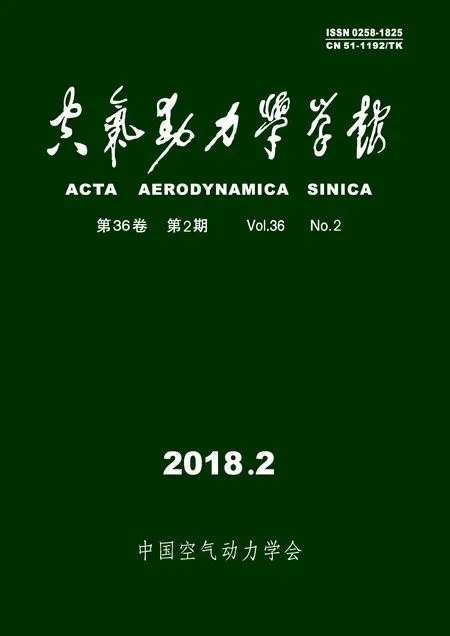动力学模态分解及其在流体力学中的应用
寇家庆, 张伟伟
(西北工业大学 翼型叶栅空气动力学国家重点实验室, 陕西 西安 710072)
0 引 言
近年来,随着计算机和信息技术的迅猛发展,各行业应用所产生的数据量呈爆炸性增长[1]。因此,寻求有效的大数据提取、分析和处理技术,逐渐成为相关行业的现实需求,而基于数据驱动的数据挖掘、机器学习、深度学习技术,则成为解决海量数据处理和分析的主要渠道。在流体力学的研究中,随着高精度数值模拟技术的发展[2],非线性、非定常流场仿真的精细度不断提高,海量的计算和存储资源同样制约着学科发展。实验流体力学领域,随着全场动态精细化的流动测量与显示技术的发展,也面临着相似的问题。为了提高非定常流场动力学的分析效率、理解复杂的流动结构和相关机理,研究者结合各种数据驱动算法,相继发展了非定常流场模态分解和气动力建模与降阶技术,并逐渐成为当前研究热点。这些方法不仅降低了计算成本,而且很大程度上缓解了模型的复杂性和易分析易设计性之间的矛盾。通过上述方法得到的非定常流场降阶模型(Reduced-Order Model, ROM),对飞行力学[3]、流固耦合[4-6]、流动控制[7]等领域的研究有重要意义。
根据所需流场样本类型及建模方法的不同,目前的降阶模型主要包括两类:第一类是基于输入输出样本的系统辨识方法,这种方法通过数学手段,直接建立输入输出数据之间的映射关系,模型结构简单,且所需数据量小;第二类是基于特征提取技术的模态分解方法,其本质是寻找一组低维的子空间(即流动模态或相干结构),将高维、复杂非定常流场表示为这些子空间在低维坐标系上的叠加,从而在低维空间中描述流场演化。这种技术需要高维、大规模的流场数据作为样本,可以直观的展示出非定常流动随时间和空间的演化规律,因此对于非定常流场的机理分析有重要意义。典型的方法包括本征正交分解(Proper Orthogonal Decomposition, POD)和动力学模态分解(Dynamic Mode Decomposition, DMD)两类。
DMD是一种从非定常实验测量或数值模拟流场中提取动力学信息的数据驱动算法,能够用于分析复杂非定常流动的主要特征,或建立低阶的流场动力学模型,该方法由Schmid提出[8-9]。DMD方法的本质是将流动演化看做线性动力学过程,通过对整个过程的流场快照进行特征分析,得到表征流场信息的低阶模态及其对应的特征值(或Ritz值)。DMD方法的最大特点在于,分解得到的模态具有单一的频率和增长率,因此在分析动力学线性和周期性流动中有很大优势。另外,DMD可以直接通过各个模态的特征值表征流动演化过程,因此不需要额外建立控制方程。这种同时得到模态特征和动力学信息的特点,使DMD方法相比于目前基于系统辨识(利用时间序列和输入输出样本)和特征提取(利用空间样本)的流场降阶而言,具有时空耦合建模的独特优势。

由于数学表达式简单,计算易于实现, DMD方法已被应用于实验或数值模拟条件下多种复杂流动现象的分析上。此外,在处理实际问题的过程中,由于流场样本维度高、实验数据存在噪声、采样间隔受限等因素,标准DMD方法仍有一定局限性。为此,从DMD提出后,发展了很多改进的DMD方法,以克服标准DMD存在的问题。虽然目前国外已有综述论文提及该方法,但都只是将其作为讨论的一部分,并没有对DMD方法本身进行系统介绍。本文重点描述了DMD方法从提出至今,在理论及应用层面的发展现状,同时对比了DMD与其他方法的区别与联系,并描述了其在流体力学中的应用,展示了典型的模态分解算例,最后总结了目前DMD相关的研究现状及未来的发展情况。
1 DMD方法及其改进
在进行DMD分析之前,首先需要对非定常流场时间序列进行处理。通过试验或数值仿真得到的N个时刻快照,可以写成从1到N时刻的快照序列形式,即{x1,x2,x3,...,xN},其中第i个时刻的快照表示为列向量xi,且任意两个快照之间的时间间隔均为Δt。假设流场xi+1可以通过流场xi的线性映射表示:
xi+1=Axi
(1)
其中A为高维流场的系统矩阵。如果本身动态系统为非线性,则这个过程就是一个线性估计过程。根据假设的线性映射关系,矩阵A能够反映系统的动态特征。由于A的维数很高,需要通过降阶的方法从数据序列中计算出A。利用1到N时刻的流场快照,可构建两个快照矩阵X=[x1,x2,x3,...,xN-1]和Y=[x2,x3,x4,...,xN]。结合式(1)的假定,可知:
Y=[x2,x3,x4,...,xN]
=[Ax1,Ax2,Ax3,...,AxN-1]=AX
(2)
DMD的目的是通过对上述快照矩阵进行数学变换,提取出主导特征值及主要模态。基于线性动力学假设,DMD可以通过两类典型方法实现:第一类采用快照之间线性无关性的假设,通过引入友矩阵对无穷维线性算子进行低阶描述;后者则结合了POD手段,通过奇异值分解对高阶算子进行相似变换,得到系统的低阶表达。两种方法均可对流场进行重构,而后者具有较好的数值稳定性。
1.1 DMD的友矩阵描述
友矩阵是一种特殊矩阵,其最后一列元素为任意值,主对角线上方或下方的元素均为1,而主对角线元素为及其余元素均为零。随着快照数目N增加,数据序列{x1,x2,x3,...,xN}已能够捕捉主要的物理特征,因此可以进一步假设,当超过某个快照数目后,流场快照之间为线性独立[9]。由此可将最后一个快照表示为之前所有流场快照的线性叠加:
xN=c1x1+c2x2+c3x3+...+cN-1xN-1=Xc
(3)
公式(2)可进一步表示为:
AX=Y=XS
(4)
上述公式中,矩阵S为友矩阵:
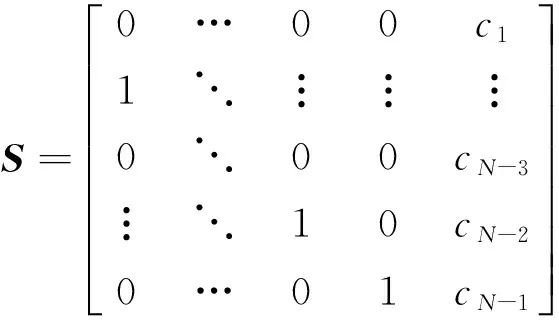
(5)
由于S中的未知量仅有c矩阵,则可求得使残差r最小的c以构造S:
r=xN-Xc
(6)
当残差最小时,S的特征值就变成A的特征值的近似。相比于A矩阵,S矩阵代表了整个系统降阶后的低维形式,其特征值能够代表A矩阵的主要特征值。S的特征值被称为Ritz特征值。S的特征分解为
S=T-1ΛT,Λ=diag(λ1,...,λN-1)
(7)
其中Λ为S的特征值组成的对角阵,对应的特征矢量为T-1的列。定义DMD模态d为矩阵D的列向量,其中D=XT-1。为实现流场重构,可引入Vandermonde矩阵:
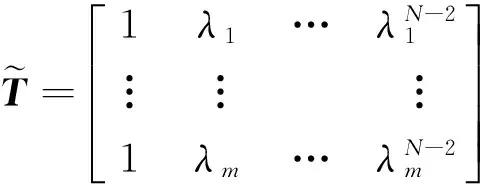
(8)



(9)
其中m为选择的DMD模态数目。任意时刻的流场快照可用前m个快照表示为:

(10)
第j个模态对应的增长率gj和频率ωj定义为:
gj=Re{lg(λj)}/Δt
(11)
ωj=Im{lg(λj)}/Δt
(12)
1.2 DMD的相似变换描述

X=UΣVH
(13)

(14)


(15)
结合式(13)和式(14),可将式(15)表示为:

(16)
此时可以将A近似为:

(17)

Φj=Uwj
(18)

zi=UHxi
(19)
得到的降阶系统控制方程为:

(20)


(21)
因此任意时刻的快照可以估计为:
=UWΝW-1UHxi-1=UWΝi-1W-1UHx1
(22)
定义Φ的每一列为一个DMD模态,根据式(18)有:
Φ=UW
(23)
定义模态振幅α为:
α=W-1z1=W-1UHx1,α=[α1,...,αr]T
(24)
其中αi为第i个模态的振幅,代表了该模态对初始快照x1的贡献。对于标准DMD方法,DMD模态按照该振幅进行排序。将式(23)和式(24)带入式(22),则任意时刻流场可进行预测:

(25)
快照序列X可以写为:
X=[x1,x2,...,xN-1]=ΦDαVand=

(26)
式(26)说明流场演化过程主要是靠Vandermonde矩阵Vand实现的,该矩阵中包含r个A矩阵的特征值。相比于1.1节基于友矩阵的DMD算法,基于相似矩阵和奇异值分解的DMD算法不要求数据是连续的时间序列,仅需要每一个时刻及其下一步的演化数据即可,同时对噪声的鲁棒性也较好[15]。
1.3 改进的DMD方法
上述标准DMD方法仅仅解决了如何获得流动模态及如何进行流场重构和预测的问题。在实际应用中,由于数据维度高、样本规模大、存在噪声及误差等问题,DMD面临着许多挑战。为解决这些问题,研究者们通过大量测试算例,观察了DMD方法的性能。Duke等[16]通过大量样本对标准DMD算法进行测试,并给出了不同信号特征(如方波、锯齿波等)下,计算得到的增长率误差棒;Bagheri[17]分析了DMD及其它线性系统分析方法在存在过程噪声时的效果;Pan等[18]分析了DMD方法的四种实现过程(直接DMD,QR分解计算友矩阵[19];连续DMD,奇异值分解计算友矩阵[9,20],截断DMD,奇异值分解过程中截断小奇异值[16],线性逆模型(Linear Inverse Modeling, LIM) DMD,通过伪逆法计算友矩阵[15])中,对于不同稳定性和频率成分正弦波的精度评估,并给出了推荐的采样和离散化参数设置。在此基础上,研究者针对不同角度和不同层次,相继发展了DMD的改进算法。根据不同改进类型,相关方法可总结如表1所示。需要指出的是,基于式(1)中的假设,DMD方法始终仅限于处理线性和周期性流动问题。如何处理强非线性流动问题,仍然是DMD的一个发展方向。

表1 改进的DMD算法总结Table 1 Overview of improved DMD algorithms

改进类型具体操作模态选择主要模态选择:快照序列投影到辨识的动态模态上得到各个模态的幅值[40];与模态范数和特征值相关的能量准则[41];模态范数与其频率的逆的加权作为各个模态的能量[42];模态系数在采样区域内的积分[43];矢量过滤准则用于模态选择[44]。其他应用CFD数值模拟过程加速收敛[45]。辨识外输入系统:带控制的DMD(DynamicModeDecompositionwithControl,DMDc)[46];输入输出DMD(Input-OutputDynamicModeDecomposition,IODMD)[47];带控制系统的EDMD[48];基于Koopman理论的带外输入建模方法[49]。
2 DMD与其他方法的关联与区别
2.1 Koopman算子理论

Koopman分析的核心概念是非线性动力学系统的演化可以通过无穷维的线性算子进行表达。以离散空间非线性动力学系统为例,其控制方程可表示如下:
xi+1=f(xi)
(27)
其中x为状态量,如流场某个时刻的所有信息。无穷维、线性的Koopman算子Ut作用在状态量的标量函数g(x)(也叫做观测量)上,其描述的动力学系统有如下特征:
Utg(x)=g(f(x))
(28)
因为Ut为线性算子,则对于任意标量函数g1、g2和系数α、β,均有Ut(αg1+βg2)(x)=αUtg1(x)+βUtg2(x)。因为观测量随时间演化,可得到
Utg(xi)=g(f(xi))=g(xi+1)
(29)
线性Koopman算子Ut的一个主要特点是其具有谱特性。对于特别的观测量φ(x),有:
Utφ(x)=φ(f(x))=λφ(x)
(30)
其中,λ和Δt分别为Koopman算子对应的特征值和时间步长,φ(x)为特征函数。如果观测量为矢量,如流场全局或局部速度压力信息,则观测量函数g(x)为矢量,此时可将矢量g(x)表示为[11]:

(31)
式(31)中矢量vj称为Koopman模态,则动力学系统的演化过程可表示为:

(32)
Koopman理论提供了利用DMD方法分析非线性动力学系统分析的独特视角。但是对于实际应用中的大多数问题,通过DMD实现的Koopman分析,其本质仍然是数据样本在动力学系统上的线性回归。Tu等[15]给出了DMD特征值与Koopman算子特征值相对应的情况,但是这要求选择合适的观测量。此外,Koopman理论统一了流体力学中的一些概念,如全局特征模态、周期解的离散傅里叶变换等[10],也为DMD方法提供了理论基础。由于正确的Koopman分析需要选择合适坐标系下的特征函数(即观测量),而在实际操作中,很难得到准确的特征函数,因此目前无论是DMD还是Koopman理论,在应用上仍面临一些挑战[54]。Williams等发展的EDMD[38,55]方法提供了一个解决思路,即利用状态量的非线性变换对状态矩阵进行增广,并将其作为观测量,可能会得到更准确的Koopman算子。Brunton等[56]研究了选择合适的非线性观测量,以实现Koopman算子在非线性系统控制问题上的应用。
2.2 POD
在DMD方法提出之前,最常用的流场模态分析方法是POD[57-60]。POD方法能够将高阶、非线性系统通过正交模态投影到低维状态空间上,同时保证在给定数量模态下的最小残差[27]。POD方法的主要思路为:


(33)

(34)
其中,N为流场快照的数目,uj(x)为POD基,aj(i)为第i时刻的第j个POD基的模态系数。要得到POD基,首先应计算相关矩阵C:
C=PTP
(35)

CAj=λjAj
(36)
λj和Aj分别对应第j个特征值和特征向量。则POD基定义为:

(37)
各个模态对应的模态系数为:

(38)
值得注意的是,POD模态也可直接通过对P矩阵进行奇异值分解,直接提取U矩阵的列向量得到。可以证明这两者等价。由于特征值λ的大小对应着模态能量,可根据特征值对模态进行排序,从而得到主要的几阶流动模态,并根据式(34)重构原流场。
由于POD可以提供空间正交模态,流场的偏微分Navier-Stokes方程可以基于Galerkin方法,将POD模态投影到低维的常微分方程上,从而大幅降低控制方程的维度。然而需要指出的是,相比于POD方法,DMD方法有三大主要优势:1) 虽然POD能够保证最小的平均残差,并且将各个模态按照能量排序,但是得到的POD模态包含多种流动频率,不适用于物理现象的解释。DMD模态的单倍频特征则更方便研究者进行流动机理分析;2) POD方法无法得到模态稳定性特征,而DMD模态则具有对应的特征值,因此能够直接给出各阶模态的特征频率和稳定性;3) 从建立非定常流场降阶模型的角度上,POD方法本身无法得到动力学模型,需要通过嵌入式Galerkin方法或非嵌入式的代理模型方法,对模态系数的演化进行建模;而DMD则直接可通过各个模态的特征值表征流动演化过程,不必复杂的Galerkin投影计算或构建代理模型。这也就是前文提到的DMD方法具有的时空耦合建模优势。
3 DMD方法的应用
DMD方法的提出为许多流体力学问题的机理分析提供了新的工具,同时也被应用在电力系统[61]、经济学[62-63]、机器视觉[64]等领域。对于流体系统,根据研究对象的不同,主要有台阶流动、方腔流动、射流、圆柱绕流等。主要内容总结如表2。
虽然目前DMD已广泛应用于大量流体力学问题,但是在大多数研究中,DMD仅仅作为其他模态分解方法(如POD,全局稳定性分析)的一个替代手段,并在具有典型频率成分的流动问题上发挥优势。然而,除了流动物理现象的分析外,DMD在建立非定常流体模型上也有很大潜力。通过DMD,发现动力学线性系统的内在规律,并用DMD所描述的低阶模型预测非定常流动现象,实现多场耦合分析、动力学系统控制,对于理解和应用模态分解方法具有重要意义。此外,除了流体力学问题,对于其他领域动力学系统的建模问题,如天气预测、地磁场观测、人脑信号处理等[150],DMD方法仍有广阔的应用前景。
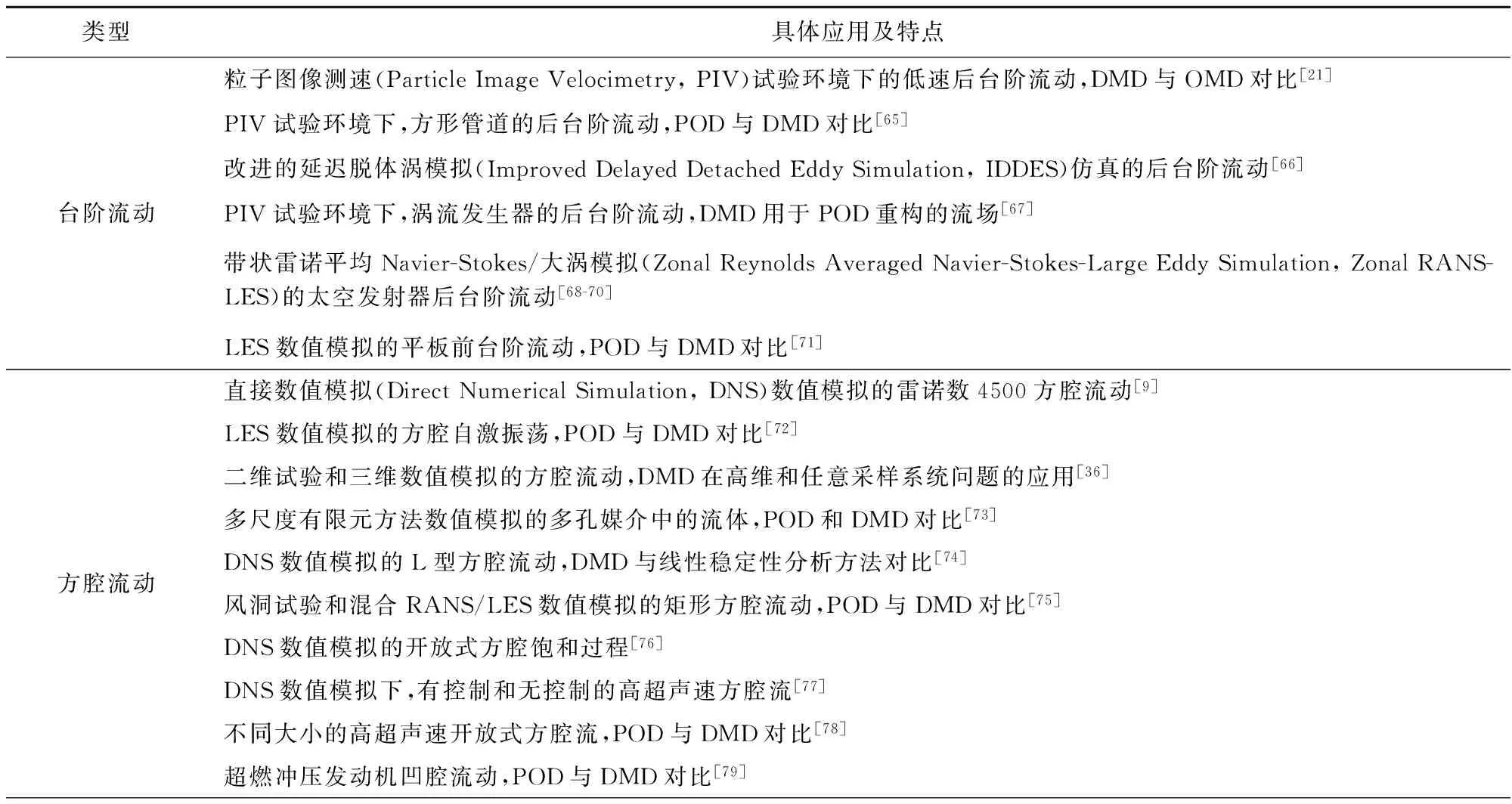
表2 DMD在流体力学问题中的应用Table 2 Applications of DMD in fluid dynamics
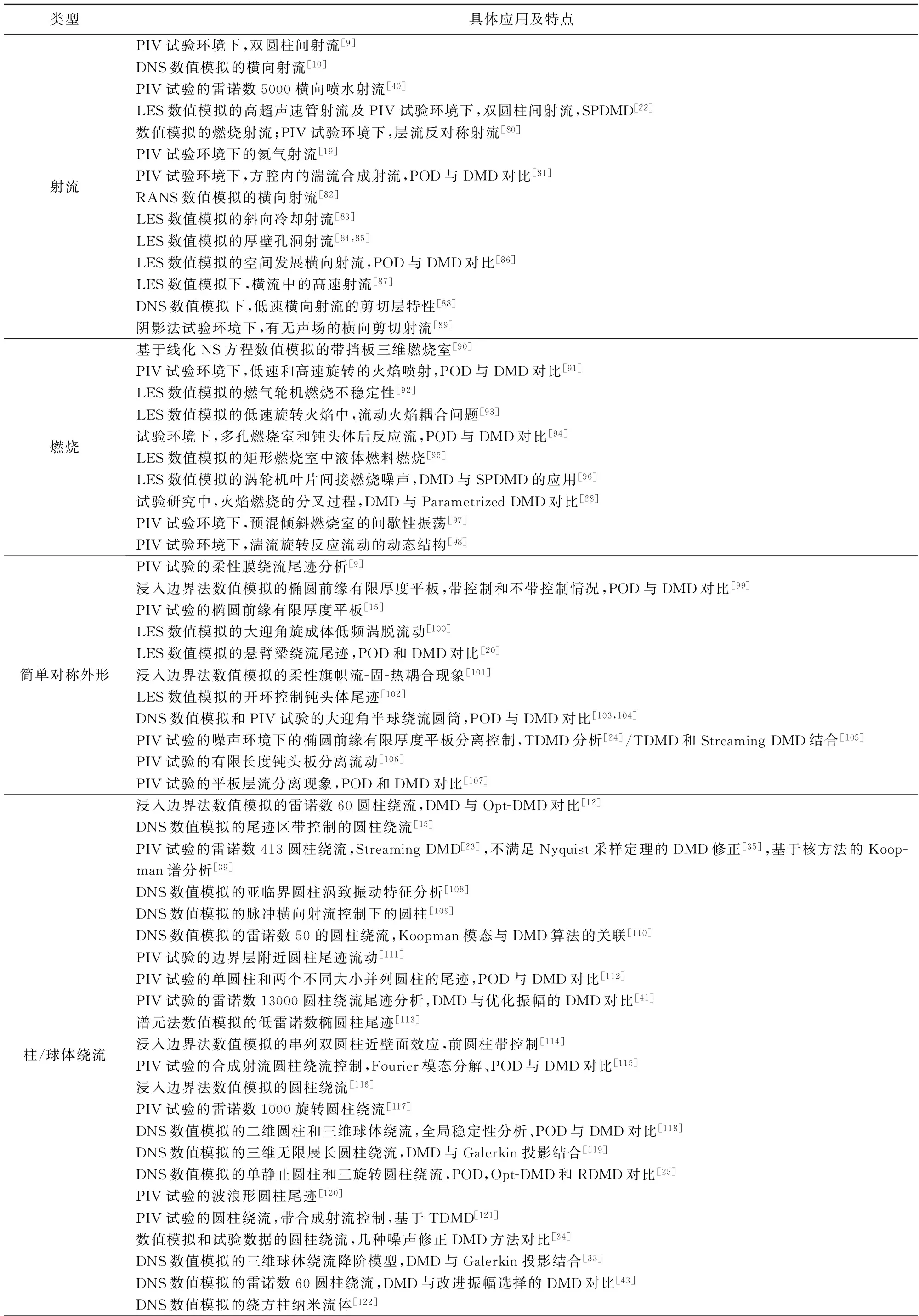
类型具体应用及特点射流PIV试验环境下,双圆柱间射流[9]DNS数值模拟的横向射流[10]PIV试验的雷诺数5000横向喷水射流[40]LES数值模拟的高超声速管射流及PIV试验环境下,双圆柱间射流,SPDMD[22]数值模拟的燃烧射流;PIV试验环境下,层流反对称射流[80]PIV试验环境下的氦气射流[19]PIV试验环境下,方腔内的湍流合成射流,POD与DMD对比[81]RANS数值模拟的横向射流[82]LES数值模拟的斜向冷却射流[83]LES数值模拟的厚壁孔洞射流[84,85]LES数值模拟的空间发展横向射流,POD与DMD对比[86]LES数值模拟下,横流中的高速射流[87]DNS数值模拟下,低速横向射流的剪切层特性[88]阴影法试验环境下,有无声场的横向剪切射流[89]燃烧基于线化NS方程数值模拟的带挡板三维燃烧室[90]PIV试验环境下,低速和高速旋转的火焰喷射,POD与DMD对比[91]LES数值模拟的燃气轮机燃烧不稳定性[92]LES数值模拟的低速旋转火焰中,流动火焰耦合问题[93]试验环境下,多孔燃烧室和钝头体后反应流,POD与DMD对比[94]LES数值模拟的矩形燃烧室中液体燃料燃烧[95]LES数值模拟的涡轮机叶片间接燃烧噪声,DMD与SPDMD的应用[96]试验研究中,火焰燃烧的分叉过程,DMD与ParametrizedDMD对比[28]PIV试验环境下,预混倾斜燃烧室的间歇性振荡[97]PIV试验环境下,湍流旋转反应流动的动态结构[98]简单对称外形PIV试验的柔性膜绕流尾迹分析[9]浸入边界法数值模拟的椭圆前缘有限厚度平板,带控制和不带控制情况,POD与DMD对比[99]PIV试验的椭圆前缘有限厚度平板[15]LES数值模拟的大迎角旋成体低频涡脱流动[100]LES数值模拟的悬臂梁绕流尾迹,POD和DMD对比[20]浸入边界法数值模拟的柔性旗帜流-固-热耦合现象[101]LES数值模拟的开环控制钝头体尾迹[102]DNS数值模拟和PIV试验的大迎角半球绕流圆筒,POD与DMD对比[103,104]PIV试验的噪声环境下的椭圆前缘有限厚度平板分离控制,TDMD分析[24]/TDMD和StreamingDMD结合[105]PIV试验的有限长度钝头板分离流动[106]PIV试验的平板层流分离现象,POD和DMD对比[107]柱/球体绕流浸入边界法数值模拟的雷诺数60圆柱绕流,DMD与Opt-DMD对比[12]DNS数值模拟的尾迹区带控制的圆柱绕流[15]PIV试验的雷诺数413圆柱绕流,StreamingDMD[23],不满足Nyquist采样定理的DMD修正[35],基于核方法的Koop-man谱分析[39]DNS数值模拟的亚临界圆柱涡致振动特征分析[108]DNS数值模拟的脉冲横向射流控制下的圆柱[109]DNS数值模拟的雷诺数50的圆柱绕流,Koopman模态与DMD算法的关联[110]PIV试验的边界层附近圆柱尾迹流动[111]PIV试验的单圆柱和两个不同大小并列圆柱的尾迹,POD与DMD对比[112]PIV试验的雷诺数13000圆柱绕流尾迹分析,DMD与优化振幅的DMD对比[41]谱元法数值模拟的低雷诺数椭圆柱尾迹[113]浸入边界法数值模拟的串列双圆柱近壁面效应,前圆柱带控制[114]PIV试验的合成射流圆柱绕流控制,Fourier模态分解、POD与DMD对比[115]浸入边界法数值模拟的圆柱绕流[116]PIV试验的雷诺数1000旋转圆柱绕流[117]DNS数值模拟的二维圆柱和三维球体绕流,全局稳定性分析、POD与DMD对比[118]DNS数值模拟的三维无限展长圆柱绕流,DMD与Galerkin投影结合[119]DNS数值模拟的单静止圆柱和三旋转圆柱绕流,POD,Opt-DMD和RDMD对比[25]PIV试验的波浪形圆柱尾迹[120]PIV试验的圆柱绕流,带合成射流控制,基于TDMD[121]数值模拟和试验数据的圆柱绕流,几种噪声修正DMD方法对比[34]DNS数值模拟的三维球体绕流降阶模型,DMD与Galerkin投影结合[33]DNS数值模拟的雷诺数60圆柱绕流,DMD与改进振幅选择的DMD对比[43]DNS数值模拟的绕方柱纳米流体[122]
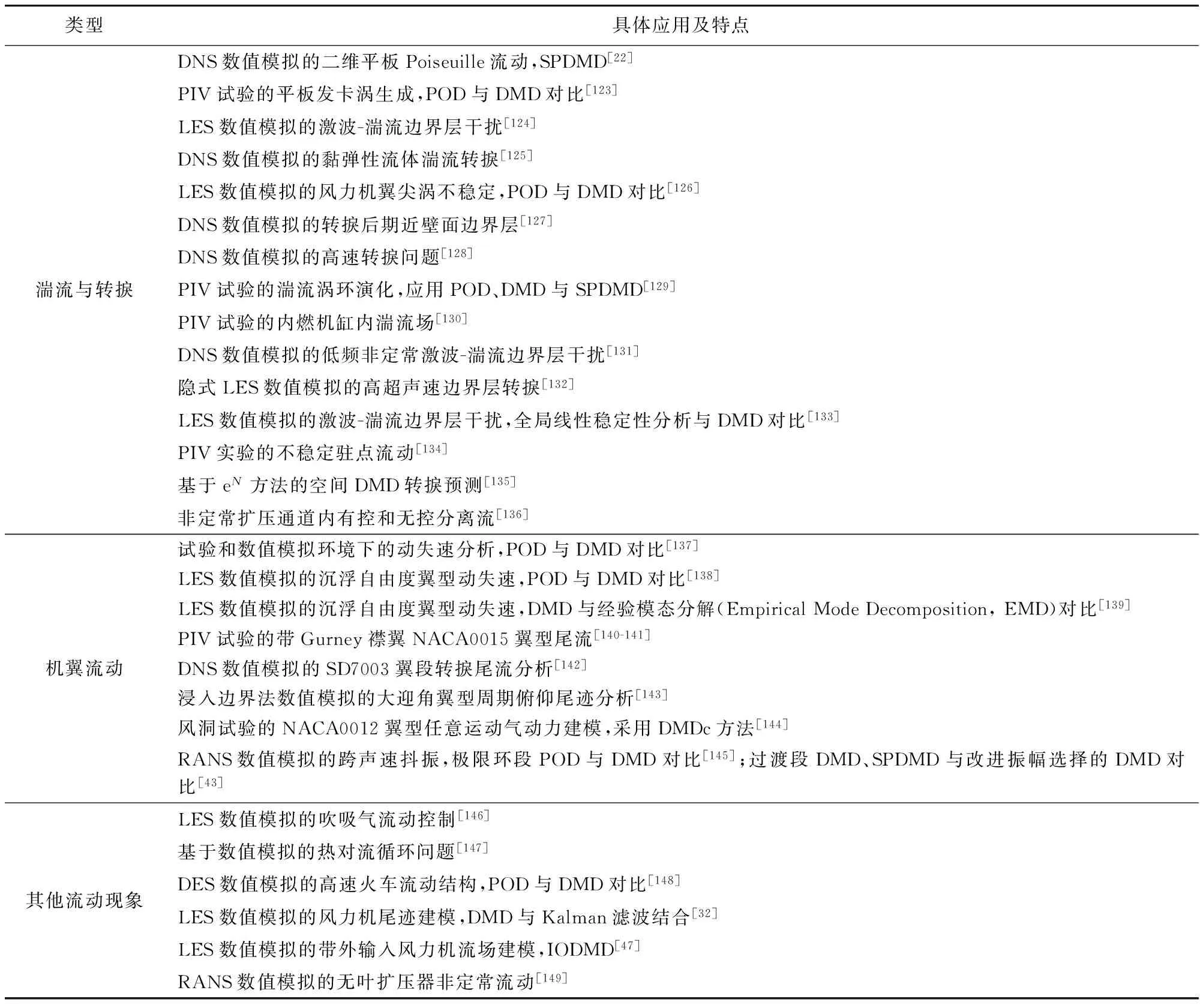
类型具体应用及特点湍流与转捩DNS数值模拟的二维平板Poiseuille流动,SPDMD[22]PIV试验的平板发卡涡生成,POD与DMD对比[123]LES数值模拟的激波-湍流边界层干扰[124]DNS数值模拟的黏弹性流体湍流转捩[125]LES数值模拟的风力机翼尖涡不稳定,POD与DMD对比[126]DNS数值模拟的转捩后期近壁面边界层[127]DNS数值模拟的高速转捩问题[128]PIV试验的湍流涡环演化,应用POD、DMD与SPDMD[129]PIV试验的内燃机缸内湍流场[130]DNS数值模拟的低频非定常激波-湍流边界层干扰[131]隐式LES数值模拟的高超声速边界层转捩[132]LES数值模拟的激波-湍流边界层干扰,全局线性稳定性分析与DMD对比[133]PIV实验的不稳定驻点流动[134]基于eN方法的空间DMD转捩预测[135]非定常扩压通道内有控和无控分离流[136]机翼流动试验和数值模拟环境下的动失速分析,POD与DMD对比[137]LES数值模拟的沉浮自由度翼型动失速,POD与DMD对比[138]LES数值模拟的沉浮自由度翼型动失速,DMD与经验模态分解(EmpiricalModeDecomposition,EMD)对比[139]PIV试验的带Gurney襟翼NACA0015翼型尾流[140-141]DNS数值模拟的SD7003翼段转捩尾流分析[142]浸入边界法数值模拟的大迎角翼型周期俯仰尾迹分析[143]风洞试验的NACA0012翼型任意运动气动力建模,采用DMDc方法[144]RANS数值模拟的跨声速抖振,极限环段POD与DMD对比[145];过渡段DMD、SPDMD与改进振幅选择的DMD对比[43]其他流动现象LES数值模拟的吹吸气流动控制[146]基于数值模拟的热对流循环问题[147]DES数值模拟的高速火车流动结构,POD与DMD对比[148]LES数值模拟的风力机尾迹建模,DMD与Kalman滤波结合[32]LES数值模拟的带外输入风力机流场建模,IODMD[47]RANS数值模拟的无叶扩压器非定常流动[149]
4 典型算例
为说明DMD方法在实际问题中的应用,本文选择了两个典型算例。首先是低维的简单线性动力学系统分析,通过该算例可以直接说明DMD的降维过程;随后,针对流场中存在间断的跨声速抖振问题,以基于不稳定定常解的线性发展过程为例,说明DMD在模态提取和流场重构中的优势及特点。
4.1 低维线性系统
因为DMD仅仅基于系统的状态量,就可捕捉系统的内在动力学,所以首先用三维不稳定线性系统的辨识问题,简单说明DMD方法的概念。该动力学系统定义为:

(39)
根据基于相似变换的DMD方法,可以对该动力学系统进行分析。假设初始条件为[0.5 1 0.8]T,快照矩阵分别为:
(40)
(41)
通过MATLAB的经济型奇异值分解算法(svd函数的econ选项),对X做奇异值分解,得到矩阵为:

(42)

(43)

(44)


(45)
即通过样本数据直接重构出系统矩阵A。上述计算展示了利用系统仿真数据,直接通过DMD重构出线性动力学系统的过程。
4.2 跨声速抖振线性发展段
跨声速抖振是由于跨声速下非定常流动的不稳定性所引起的激波周期性自激振荡,这种现象往往会对跨声速飞行器的疲劳寿命产生不利影响。针对跨声速流动中,不稳定定常解到极限环状态的线性动力学发展过程,可以利用DMD得到主要的线性发展模态。这一典型线性动力学现象可用于说明DMD在流体力学问题上的分析过程。
本文采用的算例为NACA0012翼型,选择的流动条件为马赫数Ma=0.7,雷诺数Re=3×106,该流动条件下的抖振起始迎角为α0=4.8°[151]。当前研究中,平均迎角α0=5.5°,是抖振发生的状态。流场计算通过求解非定常RANS方程实现,且采用的计算网格和程序与高传强等[151]相同。对压强快照进行DMD分析。由于流动本身不稳定,需要首先通过后缘操纵面偏转进行控制,以获得准确的不稳定定常解。基于不稳定定常解的流动发展过程如图1所示,根据升力演化过程可分成不稳定线性平衡段,过渡段和极限环状态。需要注意的是,虽然在不稳定平衡时,流动在时间上呈现动力学线性规模(即时间线化),但是由于激波的存在,流场在空间上依然展现出强的非线性特性。图1中的A区域为线性动力学过程中的采样段,B区域则为用于验证流场预测效果的预测段。采样的样本段约为两个周期,无量纲时间段为170.2到215.6,快照总数为227个。预测流场的时间范围为215.8到270。与圆柱绕流不同,在抖振流动从不稳定定常解发展到极限环状态的过程中,流动的特征频率变化不大,线性发展段的主频约为0.1975。
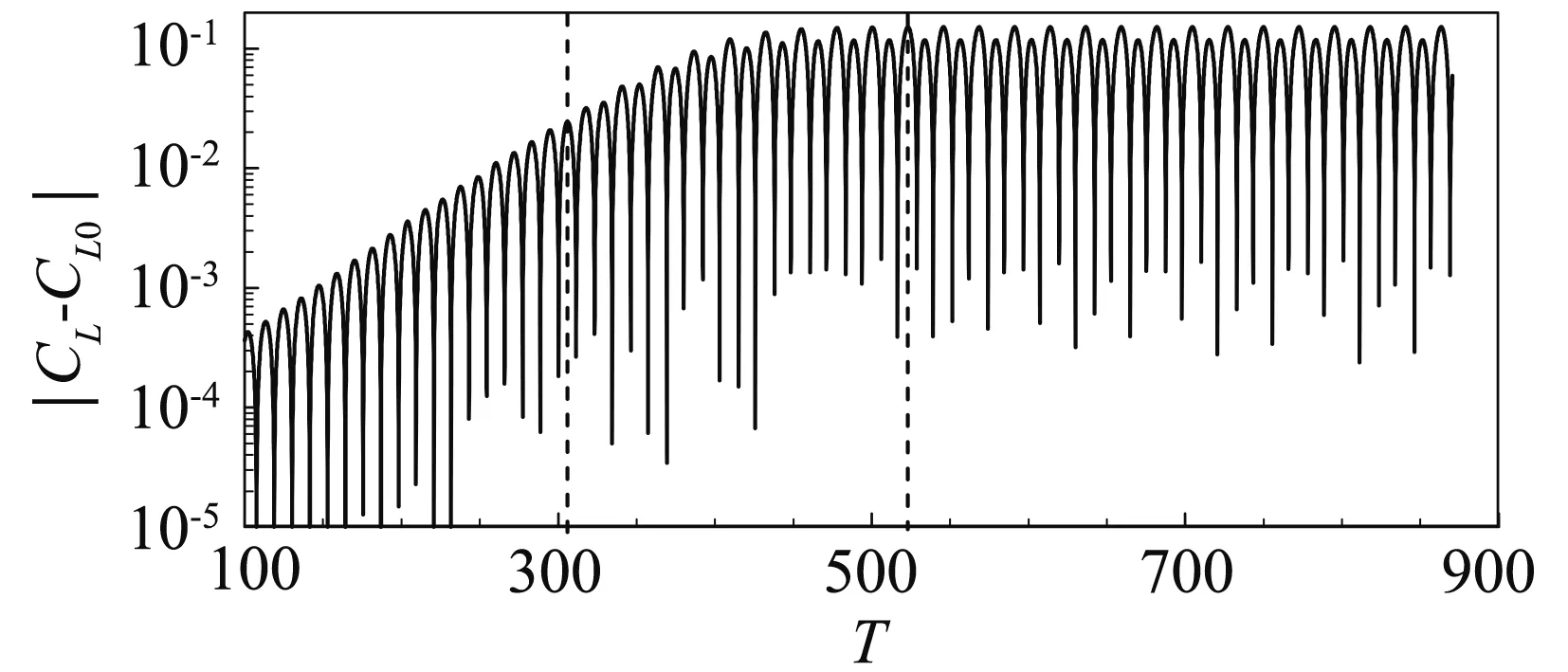
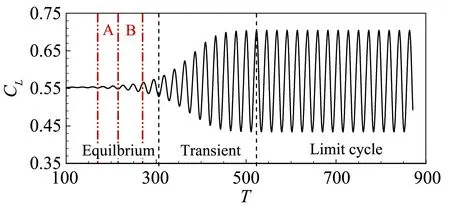
图1 跨声速NACA0012翼型升力系数随时间的响应Fig.1 Lift coefficient response of a NACA0012airfoil in transonic flow
图2展示了某时刻的流场快照及选择的典型观察点。对快照矩阵做DMD分析,根据模态系数随时间的发展情况,对不同模态对流场的贡献进行排序,并提取前5阶主要模态用于分析和流场重构。在模态排序的过程中,采用了作者发展的准则[43]。提取出的第一阶模态为静态模态,近似于平均流场。另外还包含一个漂移模态和三对共轭模态。各阶模态的幅值频率关系如图3所示。可以看出,由于采用了新的模态选择准则,捕捉出的模态不完全按照振幅大小进行排序,而是按照该模态对整个流场的贡献;对于某些具有较大振幅,但是增长率为负而不符合线性增长段特征的模态,可以通过新的模态提取准则进行剔除。这些模态被称为伪模态,其来源主要为快照中的数值计算或试验误差,以及DMD方法本身的截断误差[31]。主要的模态特征值如图3所示。图中可见选择的模态接近单位圆,但仅有静态模态在单位圆上。这是因为静态模态基本不随流场变化,因此并不增长或衰减且频率为零。提取的另外四对模态均为不稳定模态,因此特征值位于单位圆外。
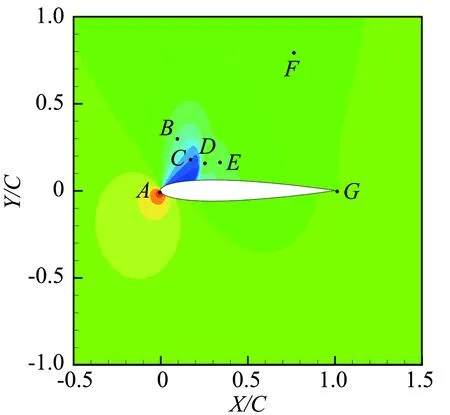
图2 某时刻压力云图及观测点Fig.2 Pressure contour and observationpoints at an instantaneous time
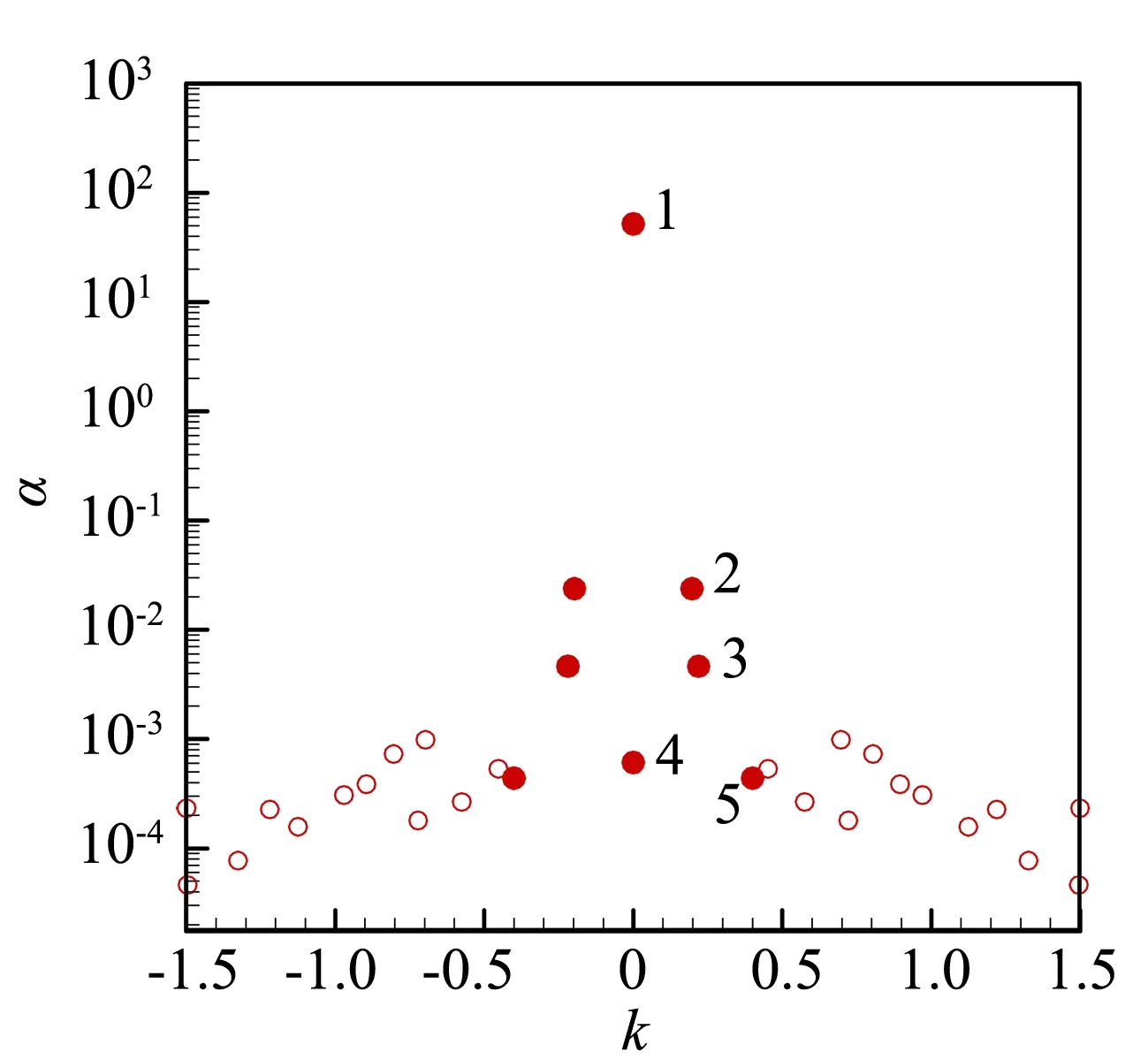
图3 DMD模态振幅与减缩频率关系Fig.3 DMD amplitude versus reduced frequency
前五阶模态的频率和增长率如表3所示。由于第一阶模态为静态模态,其与均匀流场较为相似,增长率和频率均为0。第2-3阶模态均为共轭模态,且频率接近抖振减缩频率,在增长率上略有差异。第4阶模态为漂移模态,体现了线性动力学发展过程中,流场均值随时间的变化,因此频率为0[152]。第五阶模态为两倍频模态。前五阶模态的云图如图5所示,其中各个模态均在激波间断处有较大的压强差,说明这几个模态均能够一定程度反映激波随时间的周期性运动。图6给出了采样段和预测段中,各阶模态系数的实部随时间的变化。由于一阶模态增长率近似为零,因此没有给出。从图6中可以看出线性发展过程中各阶模态的增长趋势。
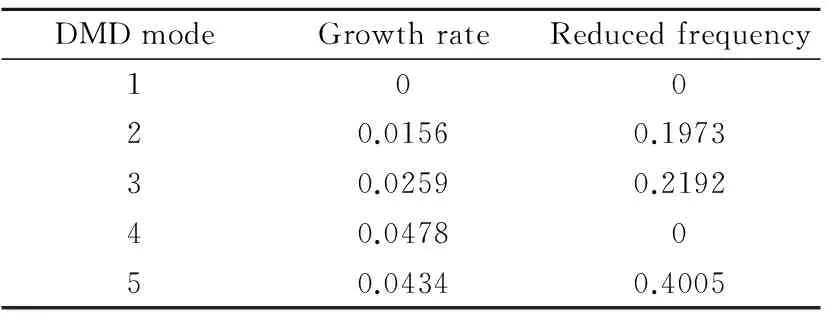
表3 主要DMD模态的增长率和频率Table3 Growth rates and frequencies ofdominant DMD modes

(a) 特征值分布
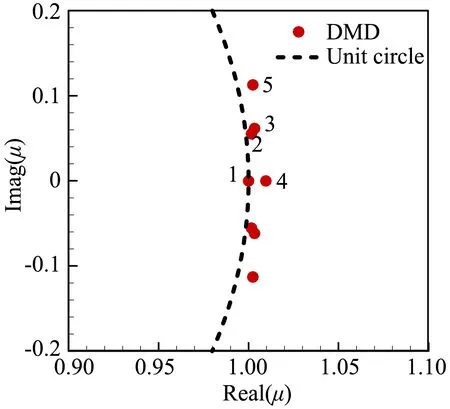
(b) 特征值局部放大图
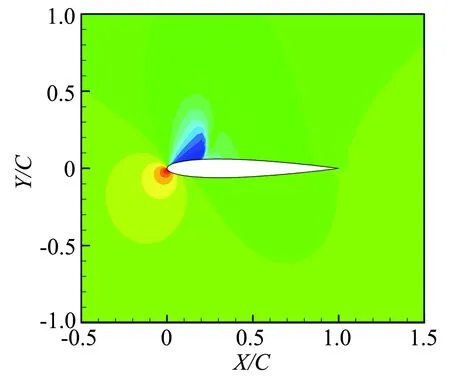
(a) 一阶DMD模态
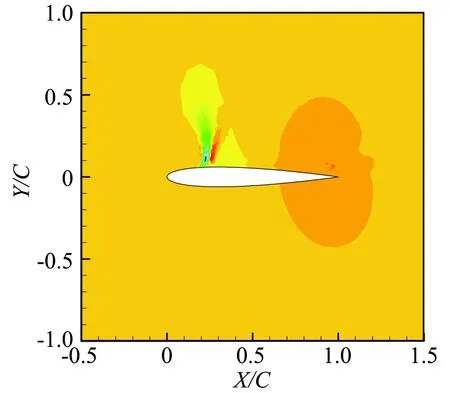
(b) 二阶DMD模态
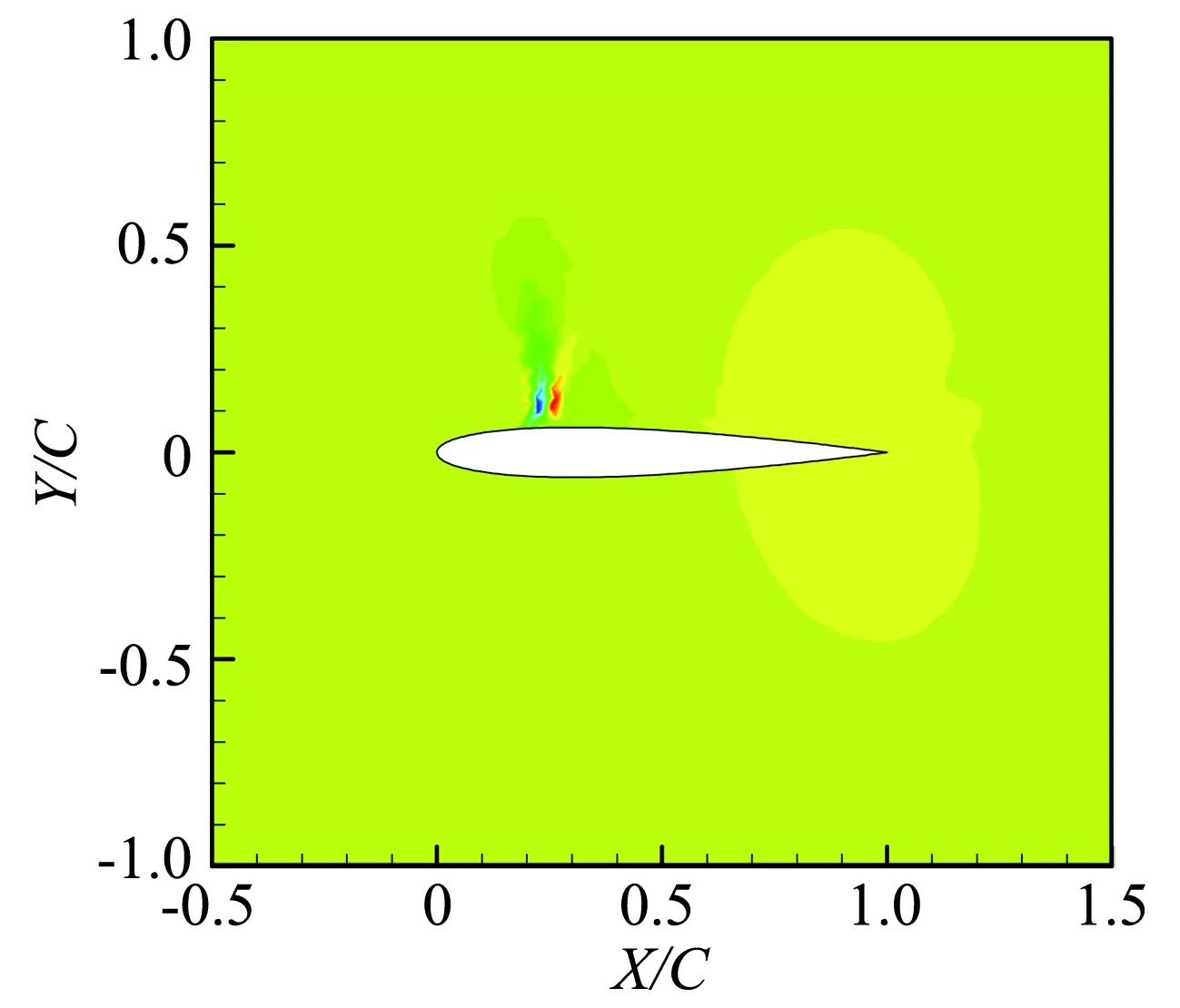
(c) 三阶DMD模态

(d) 四阶DMD模态

(e) 五阶DMD模态
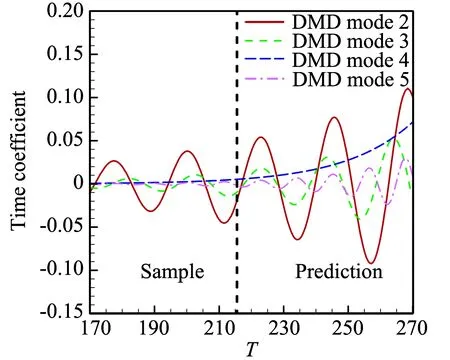
图6 模态系数随时间演化Fig.6 Mode coefficients versus time
为进一步观察DMD对流场特征的提取效果,利用得到的DMD模态进行流场重构,并建立如(26)所示的非定常流场降阶模型。选择某两个特征时刻,其无量纲时间分别为195.8 和232.4,流场压力云图对比如图7和图8。注意到195.8时刻的流场是在样本范围之内的,而232.4时刻的流场则在样本范围之外。图7和图8表明,对样本范围之内的流场重构,DMD可以给出理想的精度;而且对于样本之外的预测,DMD依然具有较好的描述能力。除了流场的直观对比外,还需要定量的误差比较。
图9给出了通过模态叠加重构的流场与真实流场的均方根误差云图。两幅图中明显看到误差最大的地方均在激波运动处,说明DMD方法对存在激波间断的流场重构能力依然有限。从两段时间的均方误差对比可见,对样本点之外的流场预测,最大误差要比样本范围内的流场预测大一个量级以上,且误差较大的区域也比样本范围内的大,这也说明DMD方法即使对线性特征内的周期性流场预测也存在一定的误差。

(a) 真实流场
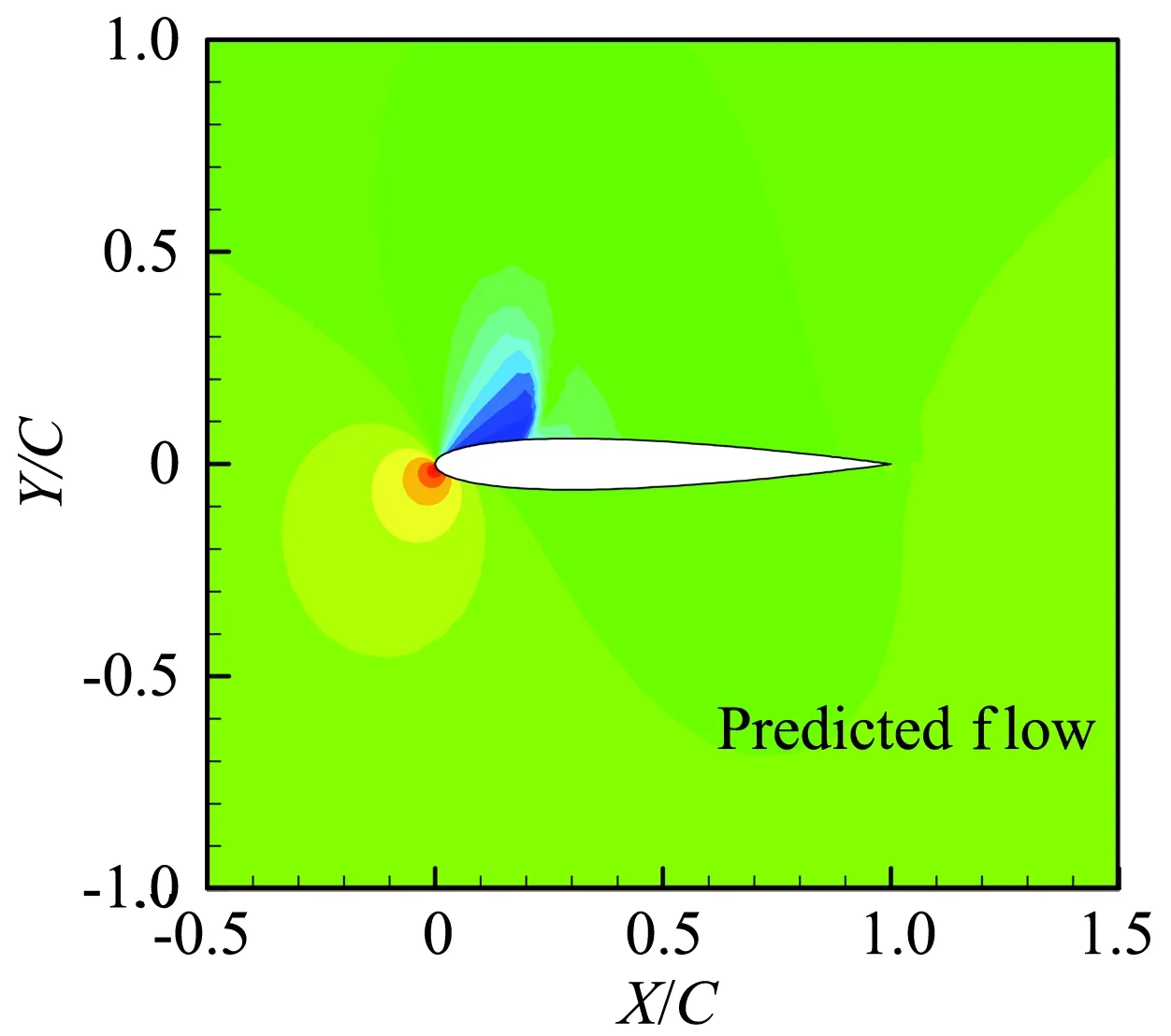
(b) 预测流场
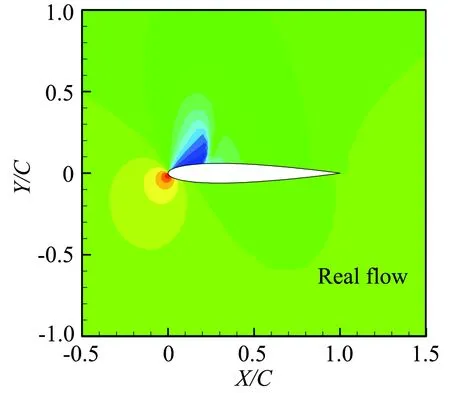
(a) 真实流场

(b) 预测流场
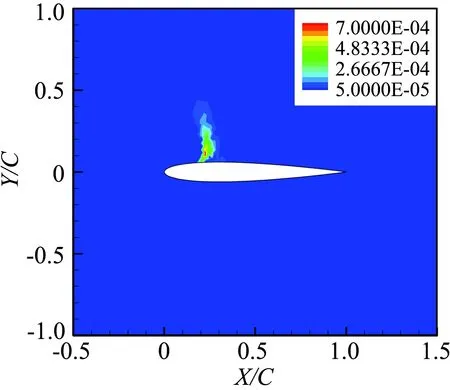
(a) 采样段
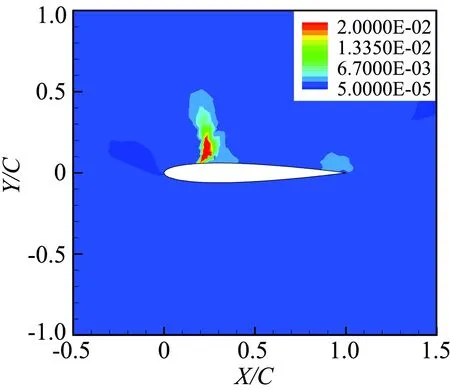
(b) 预测段
图10对比了选择的特征点C、D、E随时间变化过程中,通过5阶DMD模态叠加得到的压强与该点真实流场中压强的对比。注意到C、D和E点均处于激波晃动的区域附近。通过图10可以明显看到DMD能够以较高精度对样本区域内的压强变化进行预测,而对于线性不稳定段中超出样本点范围的压强,随着时间推进,误差逐渐增加。由此可见,对于一个线性系统而言,其线性特征可以通过DMD准确得到;然而,对于存在激波的跨声速抖振现象,即使处在流场初期的线性不稳定段,采用DMD方法也难以完全准确预测流场。这个原因是由于激波的振荡导致流场变量的非线性增长,如图10(b)所示。该结论说明即使对于存在空间非线性、而时间上可线化的动力学特征,标准DMD也不完全能够实现精确的流场预测。
通过对跨声速抖振流动线性发展段进行DMD分析,能够利用主要DMD模态特性进行流场特征分析,进而建立高精度降阶模型。基于DMD模态对流场重构和预测,能够发现在样本区域内,提取出的动态模态能够准确捕捉非定常流场的演化过程;此外,模型能够预测一定时间段内的流场特性。然而,由于跨声速激波振荡的强非线性特征,通过DMD方法准确预测激波随时间演化过程仍存在较大误差。

(a) C点
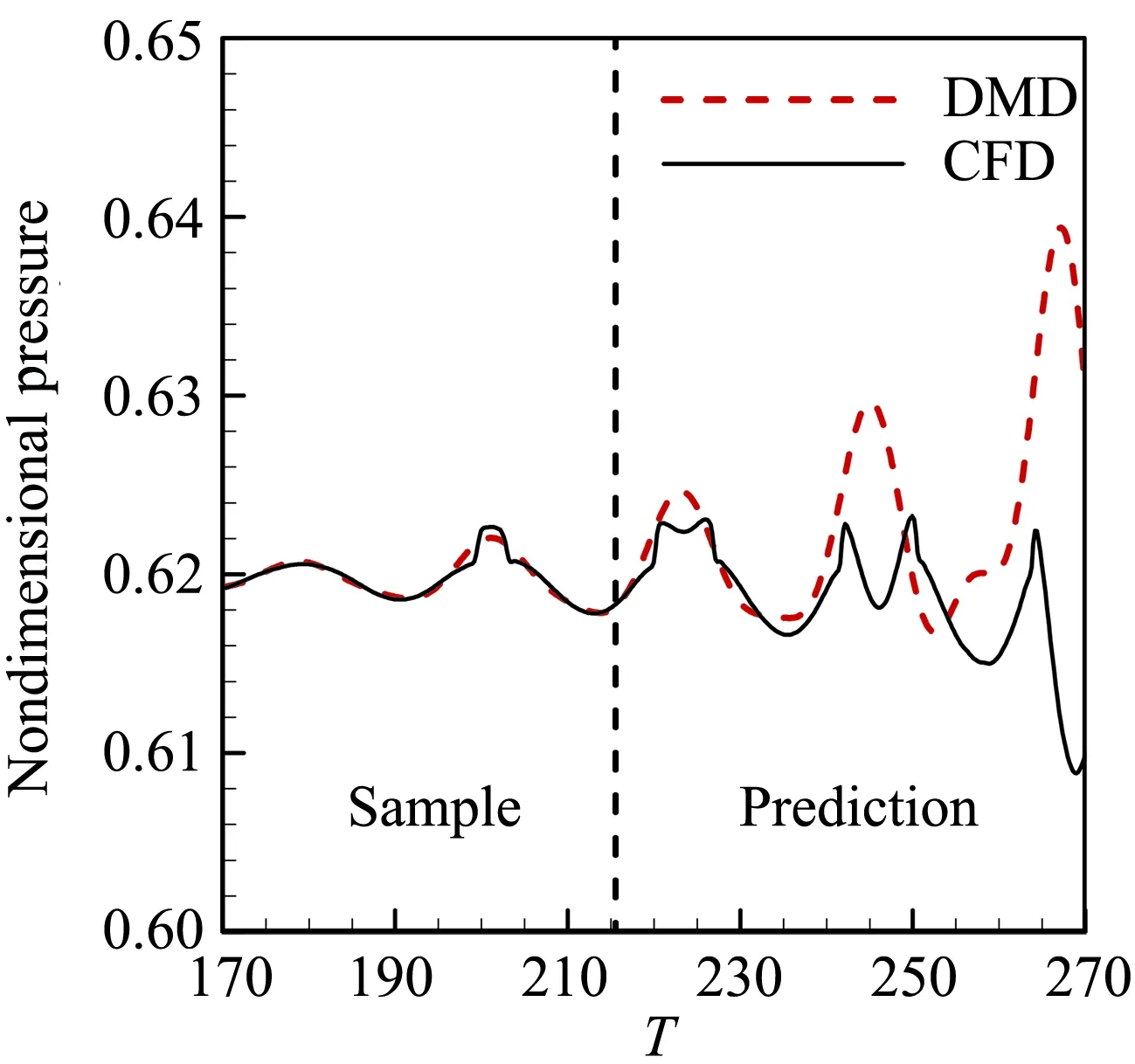
(b) D点

(c) E点
5 结 论
本文介绍了DMD方法的基本理论及相关改进算法,讨论了DMD与其他模态分解理论的关联与区别,综述了DMD在流体力学问题中的应用,并应用算例说明了DMD的实现过程。结合当前发展状况,DMD算法在未来仍有一些发展趋势:
1) 针对不同数据类型的鲁棒性。标准的DMD在无噪声干扰的线性或周期性流动分析上,具有较强的优势。针对算法的鲁棒性和存在噪声等问题,发展的改进DMD算法也能较好解决。然而,在实际应用DMD的过程中,仍然存在一些特定问题(如数据频率成分、稳定性特征、样本空间维度等),为流场的DMD分析带来困难。因此,对标准DMD方法进行适当调整,或结合其他数学方法对DMD进行扩充,仍是一个重要的发展方向;
2) 对于非线性问题的分析。由于DMD的提出是基于线性动力学假设,对于非线性动力学系统,DMD始终是一种线性的动力学分析工具。目前,Koopman算子理论对于DMD的适用性进行了一定程度拓展,从概念上说明DMD算法用于分析非线性动力学系统的可行性,并且在低雷诺数圆柱绕流问题上得到一定程度验证[110]。然而,如何选择合适的观测量、如何进一步完善Koopman理论以解释更多非线性问题、如何结合高精度非线性系统辨识技术[153]等,都是应用DMD进行非线性流场动力学分析的重要研究内容;
3) 关于带控制流动问题的研究。针对流动控制问题,目前DMD的应用主要集中在确定频率、幅值、相位的控制系统作用下,流场数据的后处理。然而,这种分析结果受到不同控制输入的局限,因此无法建立适应任意控制输入问题的低阶模型,以直接帮助控制率设计,并为多场耦合研究提供分析工具。虽然目前已经发展了带外输入的DMD算法,但是这些方法仍然需要在实际流体问题中进行测试和改进;
4) 拓展DMD的应用范围。作为一个线性动力学分析工具, DMD本身可用于辨识各个领域时空样本的内在线性动力学结构,进而实现系统特征分析和构造低阶模型;另外,从当前DMD的应用研究中不难看出,相比于直接将DMD作为一种特征分析手段,当前基于DMD发展动力学系统降阶模型的研究仍为少数。因此,在应用的深度和广度两个层面,DMD均具有广阔前景。
参考文献:
[1]Zhang L P, Deng X G, He L, et al.The opportunity and grand challenges in computational fluid dynamics by exascale computing[J].Acta Aerodynamica Sinica, 2016, 34(4): 405-417.(in Chinese)张来平, 邓小刚, 何磊, 等.E级计算给CFD带来的机遇与挑战[J].空气动力学学报, 2016, 34(4): 405-417.
[2]Zhang H X.Investigations on fidelity of high order accurate numerical simulation for computational fluid dynamics[J].Acta Aerodynamica Sinica, 2016, 34(1): 1-4.(in Chinese)张涵信.关于CFD高精度保真的数值模拟研究[J].空气动力学学报, 2016, 34(1): 1-4.
[3]Ghoreyshi M, Jirásek A, Cummings R M.Reduced order unsteady aerodynamic modeling for stability and control analysis using computational fluid dynamics[J].Progress in Aerospace Sciences, 2014, 71: 167-217.
[4]Dowell E H, Hall K C.Modeling of fluid-structure interaction[J].Annual Review of Fluid Mechanics, 2001, 33(1): 445-490.
[5]Lucia D J, Beran P S, Silva W A.Reduced-order modeling: new approaches for computational physics[J].Progress in Aerospace Sciences, 2004, 40(1-2): 51-117.
[6]Zhang W W, Ye Z Y.On unsteady aerodynamic modeling based on CFD technique and its applications on aeroelastic analysis[J].Advances in Mechanics, 2008, 38(1): 77-86.(in Chinese)张伟伟, 叶正寅.基于CFD的气动力建模及其在气动弹性中的应用[J].力学进展, 2008, 38(1): 77-86.
[7]Brunton S L, Noack B R.Closed-loop turbulence control: progress and challenges[J].Applied Mechanics Reviews, 2015, 67(5): 050801.
[8]Schmid P J, Sesterhenn J.Dynamic mode decomposition of numerical and experimental data[C]//Sixty-First Annual Meeting of the APS Division of Fluid Dynamics, San Antonio, Texas, USA, 2008: 208.
[9]Schmid P J.Dynamic mode decomposition of numerical and experimental data[J].Journal of Fluid Mechanics, 2010, 656: 5-28.

[12]Chen K K, Tu J H, Rowley C W.Variants of dynamic mode decomposition: boundary condition, Koopman, and Fourier analyses[J].Journal of Nonlinear Science, 2012, 22(6): 887-915.

[14]Rowley C W, Dawson S T M.Model reduction for flow analysis and control[J].Annual Review of Fluid Mechanics, 2017, 49: 387-417.
[15]Tu J H, Rowley C W, Luchtenburg D M, et al.On dynamic mode decomposition: theory and applications[J].Journal of Computational Dynamics, 2014, 1(2): 391-421.
[16]Duke D, Soria J, Honnery D.An error analysis of the dynamic mode decomposition[J].Experiments in Fluids, 2012, 52(2): 529-542.
[17]Bagheri S.Effects of weak noise on oscillating flows: linking quality factor, Floquet modes, and Koopman spectrum[J].Physics of Fluids, 2014, 26(9): 094104.
[18]Pan C, Xue D, Wang J J.On the accuracy of dynamic mode decomposition in estimating instability of wave packet[J].Experiments in Fluids, 2015, 56(8): 164.
[19]Schmid P J, Li L, Juniper M P, et al.Applications of the dynamic mode decomposition[J].Theoretical and Computational Fluid Dynamics, 2011, 25(1-4): 249-259.
[20]Cesur A, Carlsson C, Feymark A, et al.Analysis of the wake dynamics of stiff and flexible cantilever beams using POD and DMD[J].Computers & Fluids, 2014, 101: 27-41.
[21]Wynn A, Pearson D S, Ganapathisubramani B, et al.Optimal mode decomposition for unsteady flows[J].Journal of Fluid Mechanics, 2013, 733: 473-503.

[23]Hemati M S, Williams M O, Rowley C W.Dynamic mode decomposition for large and streaming datasets[J].Physics of Fluids, 2014, 26(11): 111701.
[24]Hemati M S, Rowley C W, Deem E A, et al.De-biasing the dynamic mode decomposition for applied Koopman spectral analysis of noisy datasets[J].Theoretical and Computational Fluid Dynamics, 2017, 31(4): 349-368.
[25]Noack B R, Stankiewicz W, Morzyński M, et al.Recursive dynamic mode decomposition of transient and post-transient wake flows[J].Journal of Fluid Mechanics, 2016, 809: 843-872.
[26]Sieber M, Paschereit C O, Oberleithner K.Spectral proper orthogonal decomposition[J].Journal of Fluid Mechanics, 2016, 792: 798-828.
[27]Noack B R.From snapshots to modal expansions-bridging low residuals and pure frequencies[J].Journal of Fluid Mechanics, 2016, 802: 1-4.
[28]Sayadi T, Schmid P J, Richecoeur F, et al.Parametrized data-driven decomposition for bifurcation analysis, with application to thermo-acoustically unstable systems[J].Physics of Fluids, 2015, 27(3): 037102.
[29]Bistrian D A, Navon I M.Randomized dynamic mode decomposition for non-intrusive reduced order modelling[J].International Journal for Numerical Methods in Engineering, 2017, 112(1): 3-25.
[30]Kutz J N, Fu X, Brunton S L.Multiresolution dynamic mode decomposition[J].SIAM Journal on Applied Dynamical Systems, 2016, 15(2): 713-735.
[31]Le Clainche S, Vega J M.High order dynamic mode decomposition[J].SIAM Journal on Applied Dynamical Systems, 2017, 16(2): 882-925.
[32]Iungo G V, Santoni-Ortiz C, Abkar M, et al.Data-driven reduced order model for prediction of wind turbine wakes[J].Journal of Physics: Conference Series, 2015, 625(1): 83-90.
[33]Stankiewicz W, Morzyński M, Kotecki K, et al.On the need of mode interpolation for data-driven Galerkin models of a transient flow around a sphere[J].Theoretical and Computational Fluid Dynamics, 2017, 31(2): 111-126.
[34]Dawson S T M, Hemati M S, Williams M O, et al.Characterizing and correcting for the effect of sensor noise in the dynamic mode decomposition[J].Experiments in Fluids, 2016, 57(3): 42-61.
[35]Tu J H, Rowley C W, Kutz J N, et al.Spectral analysis of fluid flows using sub-Nyquist-rate PIV data[J].Experiments in Fluids, 2014, 55(9): 1805.
[36]Guéniat F, Mathelin L, Pastur L R.A dynamic mode decomposition approach for large and arbitrarily sampled systems[J].Physics of Fluids, 2015, 27(2): 025113.
[37]Brunton S L, Proctor J L, Tu J H, et al.Compressed sensing and dynamic mode decomposition[J].Journal of Computational Dynamics, 2016, 2(2): 165-191.
[38]Williams M O, Kevrekidis I G, Rowley C W.A data-driven approximation of the Koopman operator: extending dynamic mode decomposition[J].Journal of Nonlinear Science, 2015, 25(6): 1307-1346.
[39]Williams M O, Rowley C W, Kevrekidis I G.A kernel-based method for data-driven Koopman spectral analysis[J].Journal of Computational Dynamics, 2017, 2(2): 247-265.
[40]Schmid P J, Violato D, Scarano F.Decomposition of time-resolved tomographic PIV[J].Experiments in Fluids, 2012, 52(6): 1567-1579.
[41]Tissot G, Cordier L, Benard N, et al.Model reduction using dynamic mode decomposition[J].Comptes Rendus Mécanique, 2014, 342(6-7): 410-416.
[42]Bistrian D A, Navon I M.An improved algorithm for the shallow water equations model reduction: dynamic mode decomposition vs POD[J].International Journal for Numerical Methods in Fluids, 2015, 78(9): 552-580.
[43]Kou J Q, Zhang W W.A criterion to select dominant modes of dynamic mode decomposition[J].European Journal of Mechanics-B/Fluids, 2017, 62: 109-129.
[44]Bistrian D A, Navon I M.The method of dynamic mode decomposition in shallow water and a swirling flow problem[J].International Journal for Numerical Methods in Fluids, 2017, 83(1): 73-89.
[45]Andersson N.A non-intrusive acceleration technique for compressible flow solvers based on dynamic mode decomposition[J].Computers & Fluids, 2016, 133: 32-42.
[46]Proctor J L, Brunton S L, Kutz J N.Dynamic mode decomposition with control[J].SIAM Journal on Applied Dynamical Systems, 2016, 15(1): 142-161.
[47]Annoni J, Seiler P.A method to construct reduced-order parameter-varying models[J].International Journal of Robust and Nonlinear Control, 2016, 27(4): 582-597.
[48]Williams M O, Hemati M S, Dawson S T M, et al.Extending data-driven Koopman analysis to actuated systems[C]//Proceedings of the 10th IFAC Symposium on Nonlinear Control Systems.Marriott Hotel Monterey, California, USA, 2016: 704-709.
[49]Proctor J L, Brunton S L, Kutz J N.Including inputs and control within equation-free architectures for complex systems[J].The European Physical Journal Special Topics, 2016, 225(13): 2413-2434.
[50]Koopman B O.Hamiltonian systems and transformation in Hilbert space[J].Proceedings of the National Academy of Sciences, 1931, 17(5): 315-318.

[52]Budisic M, Mohr R, Mezic I.Applied Koopmanism[J].Chaos, 2012, 22(4): 047510.
[53]Jia J Y.Research on the algorithms and applications of Koopman operator on some dynamical systems[D].Beijing: Tsinghua University, 2015.(in Chinese)贾继莹.Koopman算符在一些动力系统中的算法和应用研究[D].北京: 清华大学, 2015.
[54]Taira K, Brunton S L, Dawson S T M, et al.Modal analysis of fluid flows: an overview[J].AIAA J, 2017, 55(12): 4013-4041.

[56]Brunton S L, Brunton B W, Proctor J L, et al.Koopman invariant subspaces and finite linear representations of nonlinear dynamical systems for control[J].PLoS ONE, 2016, 11(2): e0150171.
[57]Holmes P, Lumley J L, Berkooz G, et al.Turbulence, coherent structures, dynamical systems and symmetry[M].Cambridge University Press, 2012.
[58]Berkooz G, Holmes P, Lumley J L.The proper orthoghnal decomposition in the analysis of turbulent flows[J].Annual Review of Fluid Mechanics, 1993, 25(1): 539-575.
[59]Wang H F, Xu S J.On the bistable phenomenon of a finite length square cylinder wake with POD method.Acta Aerodynamica Sinica, 2014, 32(6): 827-833.(in Chinese)王汉封, 徐胜金.用POD方法研究有限长正方形棱柱尾流的双稳态现象[J].空气动力学学报, 2014, 32(6): 827-833.
[60]Dong S H, Shi A M, Ye Z Y, et al.CFD computation and POD analysis for transonic buffet on a supercritical airfoil[J].Acta Aerodynamica Sinica, 2015, 33(4): 481-487.(in Chinese)董圣华, 史爱明, 叶正寅, 等.超临界翼型跨声速抖振CFD计算和POD分析[J].空气动力学学报, 2015, 33(4): 481-487.
[61]Barocio E, Pal B C, Thornhill N F, et al.A dynamic mode decomposition framework for global power system oscillation analysis[J].IEEE Transactions on Power Systems, 2015, 30(6): 2902-2912.
[62]Cui L X, Long W.Trading strategy based on dynamic mode decomposition: tested in Chinese stock market[J].Physica A: Statistical Mechanics and its Applications, 2016, 461: 498-508.
[63]Hua J C, Roy S, McCauley J L, et al.Using dynamic mode decomposition to extract cyclic behavior in the stock market[J].Physica A: Statistical Mechanics and its Applications, 2016, 448: 172-180.
[64]Tirunagari S, Poh N, Wells K, et al.Movement correction in DCE-MRI through windowed and reconstruction dynamic mode decomposition[J].Machine Vision and Applications, 2017, 28(3-4): 393-407.
[65]Sampath R, Chakravarthy S R.Proper orthogonal and dynamic mode decompositions of time-resolved PIV of confined backward-facing step flow[J].Experiments in Fluids, 2014, 55(9): 1792.
[66]Horchler T, Mani K V, Hannemann K.Dynamic mode decomposition of backward facing step flow simulation data.AIAA 2015-3411[R].Reston: AIAA, 2015.
[67]Ma X Y, Geisler R, Schröder A.Experimental investigation of three-dimensional vortex structures downstream of vortex generators over a backward-facing step[J].Flow, Turbulence and Combustion, 2017, 98(2): 389-415.
[68]Statnikov V, Roidly B, Meinke M, et al.Analysis of spatio-temporal wake modes of space launchers at transonic flow.AIAA 2016-1116[R].Reston: AIAA, 2016.
[69]Statnikov V, Bolgar I, Scharnowski S, et al.Analysis of characteristic wake flow modes on a generic transonic backward-facing step configuration[J].European Journal of Mechanics - B/Fluids, 2016, 59: 124-134.
[70]Statnikov V, Meinke M, Schröder W.Reduced-order analysis of buffet flow of space launchers[J].Journal of Fluid Mechanics, 2017, 815: 1-25.
[71]Debesse P, Pastur L, Lusseyran F, et al.A comparison of data reduction techniques for the aeroacoustic analysis of flow over a blunt flat plate[J].Theoretical and Computational Fluid Dynamics, 2015, 30(3): 253-274.
[72]Seena A, Sung H J.Dynamic mode decomposition of turbulent cavity flows for self-sustained oscillations[J].International Journal of Heat and Fluid Flow, 2011, 32(6): 1098-1110.
[73]Ghommem M, Presho M, Calo V M, et al.Mode decomposition methods for flows in high-contrast porous media.Global-local approach[J].Journal of Computational Physics, 2013, 253: 226-238.
[74]Ferrer E, De Vicente J, Valero E.Low cost 3D global instability analysis and flow sensitivity based on dynamic mode decomposition and high-order numerical tools[J].International Journal for Numerical Methods in Fluids, 2014, 76(3): 169-184.
[75]Casper K M, Arunajatesan S.Modal decomposition of pressure data in cavity flows.AIAA 2015-2938[R].Reston: AIAA, 2015.
[76]Vinha N, Meseguer-Garrido F, De Vicente J, et al.A dynamic mode decomposition of the saturation process in the open cavity flow[J].Aerospace Science and Technology, 2016, 52: 198-206.
[77]Zhang C, Wan Z H, Sun D J.Mode transition and oscillation suppression in supersonic cavity flow[J].Applied Mathematics and Mechanics, 2016, 37(7): 941-956.
[78]Sampath P, Sinhamahapatra K P.Numerical analysis of characteristic features of shallow and deep cavity in supersonic flow[J].International Journal of Computational Fluid Dynamics, 2016, 30(3): 231-255.
[79]Ye K, Ye Z Y, Wu J, et al.Stability analysis of scramjet open cavity flow base on POD and DMD method[J].Physics of Gases, 2016, 1(5): 39-51.(in Chinese)叶坤, 叶正寅, 武洁, 等.DMD 和POD对超燃冲压发动机凹腔流动的稳定性分析[J].气体物理, 2016, 1(5): 39-51.
[80]Schmid P J.Application of the dynamic mode decomposition to experimental data[J].Experiments in Fluids, 2011, 50(4): 1123-1130.
[81]Semeraro O, Bellani G, Lundell F.Analysis of time-resolved PIV measurements of a confined turbulent jet using POD and Koopman modes[J].Experiments in Fluids, 2012, 53(5): 1203-1220.
[82]Song G, Alizard F, Robinet J C, et al.Global and Koopman modes analysis of sound generation in mixing layers[J].Physics of Fluids, 2013, 25(12): 124101.
[83]Kalghatgi P, Acharya S.Modal analysis of inclined film cooling jet flow[J].Journal of Turbomachinery, 2014, 136(8): 081007.
[84]Alenius E.Mode switching in a thick orifice jet, an LES and dynamic mode decomposition approach[J].Computers & Fluids, 2014, 90: 101-112.
[85]Nair V, Alenius E, Boij S, et al.Inspecting sound sources in an orifice-jet flow using Lagrangian coherent structures[J].Computers & Fluids, 2016, 140: 397-405.
[86]Wan Z H, Zhou L, Wang B F, et al.Dynamic mode decomposition of forced spatially developed transitional jets[J].European Journal of Mechanics - B/Fluids, 2015, 51: 16-26.
[87]Chai X C, Iyer P S, Mahesh K.Numerical study of high speed jets in crossflow[J].Journal of Fluid Mechanics, 2015, 785: 152-188.
[88]Iyer P S, Mahesh K.A numerical study of shear layer characteristics of low-speed transverse jets[J].Journal of Fluid Mechanics, 2016, 790: 275-307.
[89]Hua J C, Gunaratne G H, Talley D G, et al.Dynamic-mode decomposition based analysis of shear coaxial jets with and without transverse acoustic driving[J].Journal of Fluid Mechanics, 2016, 790: 5-32.
[90]Jourdain G, Eriksson L-E, Kim S H, et al.Application of dynamic mode decomposition to acoustic-modes identification and damping in a 3-dimensional chamber with baffled injectors[J].Journal of Sound and Vibration, 2013, 332(18): 4308-4323.
[91]Markovich D M, Abdurakipov S S, Chikishev L M, et al.Comparative analysis of low- and high-swirl confined flames and jets by proper orthogonal and dynamic mode decompositions[J].Physics of Fluids, 2014, 26(6): 065109.
[92]Motheau E, Nicoud F, Poinsot T.Mixed acoustic-entropy combustion instabilities in gas turbines[J].Journal of Fluid Mechanics, 2014, 749: 542-576.
[93]Carlsson H, Carlsson C, Fuchs L, et al.Large eddy simulation and extended dynamic mode decomposition of flow-flame interaction in a lean premixed low swirl stabilized flame[J].Flow, Turbulence and Combustion, 2014, 93(3): 505-519.
[94]Roy S, Hua J C, Barnhill W, et al.Deconvolution of reacting-flow dynamics using proper orthogonal and dynamic mode decompositions[J].Physical Review E, 2015, 91(1): 013001.
[95]Ghani A, Gicquel L, Poinsot T.Acoustic analysis of a liquid fuel swirl combustor using dynamic mode decomposition[R].ASME Turbo Expo: Turbine Technical Conference and Exposition, 2015, GT2015-42769.
[96]Papadogiannis D, Duchaine F, Gicquel L, et al.Assessment of the indirect combustion noise generated in a transonic high-pressure turbine stage[R].ASME Turbo Expo: Gas Turbine Technical Congress & Exposition, 2015, GT2015-42399.
[97]Sampath R, Chakravarthy S R.Investigation of intermittent oscillations in a premixed dump combustor using time-resolved particle image velocimetry[J].Combustion and Flame, 2016, 172: 309-325.
[98]Roy S, Yi T, Jiang N, et al.Dynamics of robust structures in turbulent swirling reacting flows[J].Journal of Fluid Mechanics, 2017, 816: 554-585.
[99]Tu J H, Rowley C W, Aram E, et al.Koopman spectral analysis of separated flow over a finite-thickness flat plate with elliptical leading edge.AIAA 2011-2038[R].Reston: AIAA, 2011.
[100]Ma B F, Liu T X.Low-frequency vortex oscillation around slender bodies at high angles-of-attack[J].Physics of Fluids, 2014, 26(9): 091701.
[101]Lee J B, Park S G, Kim B, et al.Heat transfer enhancement by flexible flags clamped vertically in a Poiseuille channel flow[J].International Journal of Heat and Mass Transfer, 2017, 107: 391-402.
[102]Parkin D J, Thompson M C, Sheridan J.Numerical analysis of bluff body wakes under periodic open-loop control[J].Journal of Fluid Mechanics, 2014, 739: 94-123.
[103]Clainche S L, Li J I, Theofilis V, et al.Flow around a hemisphere-cylinder at high angle of attack and low Reynolds number.Part I: Experimental and numerical investigation[J].Aerospace Science and Technology, 2015, 44: 77-87.
[104]Clainche S L, Li J I, Theofilis V, et al.Flow around a hemisphere-cylinder at high angle of attack and low Reynolds number.Part II: POD and DMD applied to reduced domains[J].Aerospace Science and Technology, 2015, 44: 88-100.
[105]Hemati M S, Deem E A, Williams M O, et al.Improving separation control with noise-robust variants of dynamic mode decomposition.AIAA 2016-1103[R].Reston: AIAA, 2016.
[106]Liu Y Z, Zhang Q S.Dynamic mode decomposition of separated flow over a finite blunt plate: time-resolved particle image velocimetry measurements[J].Experiments in Fluids, 2015, 56(7).
[107]Lengani D, Simoni D, Ubaldi M, et al.Experimental investigation on the time-space evolution of a laminar separation bubble by proper orthogonal decomposition and dynamic mode decomposition[J].Journal of Turbomachinery, 2017, 139(3): 031006.
[108]Kou J, Zhang W, Liu Y, et al.The lowest Reynolds number of vortex-induced vibrations[J].Physics of Fluids, 2017, 29(4): 041701.
[109]Jardin T, Bury Y.Lagrangian and spectral analysis of the forced flow past a circular cylinder using pulsed tangential jets[J].Journal of Fluid Mechanics, 2012, 696: 285-300.
[110]Bagheri S.Koopman-mode decomposition of the cylinder wake[J].Journal of Fluid Mechanics, 2013, 726: 596-623.
[111]He G S, Wang J J, Pan C.Initial growth of a disturbance in a boundary layer influenced by a circular cylinder wake[J].Journal of Fluid Mechanics, 2013, 718: 116-130.
[112]Zhang Q S, Liu Y Z, Wang S F.The identification of coherent structures using proper orthogonal decomposition and dynamic mode decomposition[J].Journal of Fluids and Structures, 2014, 49: 53-72.
[113]Thompson M C, Radi A, Rao A, et al.Low-Reynolds-number wakes of elliptical cylinders: from the circular cylinder to the normal flat plate[J].Journal of Fluid Mechanics, 2014, 751: 570-600.
[114]Shaafi K, Vengadesan S.Wall proximity effects on the effectiveness of upstream control rod[J].Journal of Fluids and Structures, 2014, 49: 112-134.
[115]Ma L Q, Feng L H, Pan C, et al.Fourier mode decomposition of PIV data[J].Science China Technological Sciences, 2015, 58(11): 1935-1948.
[116]Zhang W, Wang Y, Qian Y H.Stability analysis for flow past a cylinder via lattice Boltzmann method and dynamic mode decomposition[J].Chinese Physics B, 2015, 24(6): 064701.
[117]Zhang B, Tang Z Q, Sun J, et al.Dynamic mode decomposition of flow around rotating cylinder[J].Journal of Hebei University of Technology, 2015, 44(4): 63-67.(in Chinese)张宾, 唐湛棋, 孙姣, 等.旋转圆柱绕流的动力模态分析[J].河北工业大学学报, 2015, 44(4): 63-67.
[118]Stankiewicz W, Morzyński M, Kotecki K, et al.Modal decomposition-based global stability analysis for reduced order modeling of 2D and 3D wake flows[J].International Journal for Numerical Methods in Fluids, 2016, 81(3): 178-191.
[119]Stankiewicz W, Kotecki K, Morzynski M, et al.Model order reduction for a flow past a wall-mounted cylinder[J].Archives of Mechanics, 2016, 68(2): 161-176.
[120]Wang S F, Liu Y Z.Wake dynamics behind a seal-vibrissa-shaped cylinder: a comparative study by time-resolved particle velocimetry measurements[J].Experiments in Fluids, 2016, 57(3): 32.
[121]Wang L, Feng L H.Extraction and reconstruction of individual vortex-shedding mode from bistable flow[J].AIAA Journal, 2017, 55(7): 2129-2141.
[122]Sarkar S, Ganguly S, Dalal A, et al.Mixed convective flow stability of nanofluids past a square cylinder by dynamic mode decomposition[J].International Journal of Heat and Fluid Flow, 2013, 44(4): 624-634.
[123]Tang Z Q, Jiang N.Dynamic mode decomposition of hairpin vortices generated by a hemisphere protuberance[J].Science China Physics, Mechanics & Astronomy, 2012, 55(1): 118-124.
[124]Grilli M, Schmid P J, Hickel S, et al.Analysis of unsteady behaviour in shockwave turbulent boundary layer interaction[J].Journal of Fluid Mechanics, 2012, 700: 16-28.
[125]Grilli M, Vazquez-Quesada A, Ellero M.Transition to turbulence and mixing in a viscoelastic fluid flowing inside a channel with a periodic array of cylindrical obstacles[J].Physical Review Letters, 2013, 110(17): 174501.
[126]Sarmast S, Dadfar R, Mikkelsen R F, et al.Mutual inductance instability of the tip vortices behind a wind turbine[J].Journal of Fluid Mechanics, 2014, 755: 705-731.
[127]Sayadi T, Schmid P J, Nichols J W, et al.Reduced-order representation of near-wall structures in the late transitional boundary layer[J].Journal of Fluid Mechanics, 2014, 748: 278-301.
[128]Subbareddy P K, Bartkowicz M D, Candler G V.Direct numerical simulation of high-speed transition due to an isolated roughness element[J].Journal of Fluid Mechanics, 2014, 748: 848-878.
[129]Ponitz B, Sastuba M, Brücker C.4D visualization study of a vortex ring life cycle using modal analyses[J].Journal of Visualization, 2015, 19(2): 237-259.
[130]Qin W J, Xu M, Kong L X, et al.Application of dynamic mode decomposition in in-cylinder flow field study.Transactions of CSICE, 2016, 34(4): 334-338.(in Chinese)秦文瑾, 许敏, 孔令逊, 等.动态模态分解方法在缸内湍流场研究中的应用[J].内燃机学报, 2016, 34(4): 334-338.
[131]Priebe S, Tu J H, Rowley C W, et al.Low-frequency dynamics in a shock-induced separated flow[J].Journal of Fluid Mechanics, 2016, 807: 441-477.
[132]André T, Durant A, Fedioun I.Numerical Study of supersonic boundary-layer transition due to sonic wall injection[J].AIAA Journal, 2017, 55(5): 1530-1547.
[133]Nichols J W, Larsson J, Bernardini M, et al.Stability and modal analysis of shock/boundary layer interactions[J].Theoretical and Computational Fluid Dynamics, 2017, 31(1): 33-50.
[134]Pan C, Wang J, Wang J J, et al.Dynamics of an unsteady stagnation vortical flow via dynamic mode decomposition analysis[J].Experiments in Fluids, 2017, 58(3): 21.
[135]Han Z, Wang S, Han L, et al.A novel method for automatic transition prediction of flows over airfoils based on dynamic mode decomposition[J].Acta Aeronautica et Astronautica Sinica, 2017, 38(1): 30-46.(in Chinese)韩忠华, 王绍楠, 韩莉, 等.一种基于动模态分解的翼型流动转捩预测新方法[J].航空学报, 2017, 38(1): 30-46.
[136]Hong S L, Huang G P.Introduce DMD method to study the dynamic structures of flow separation with and without control[J].Acta Aeronautica et Astronautica Sinica, 2017, 38(8): 120876.(in Chinese)洪树立, 黄国平.引入DMD 方法研究有/无控气流分离的动态结构[J].航空学报, 2017, 38(8): 120876.
[137]Mariappan S, Gardner A D, Richter K, et al.Analysis of dynamic stall using dynamic mode decomposition technique[J].AIAA Journal, 2014, 52(11): 2427-2439.
[138]Mohan A T, Gaitonde D V, Visbal M R.Model reduction and analysis of deep dynamic stall on a plunging airfoil using dynamic mode decomposition[R].AIAA 2015-1058.
[139]Mohan A T, Agostini L, Gaitonde D V, et al.A preliminary spectral decomposition and scale separation analysis of a high-fidelity dynamic stall dataset.AIAA 2016-1352[R].Reston: AIAA, 2016.
[140]Pan C, Chen H, Wang J J.Dynamical mode decomposition of complex flow field[C]//8thNational Conference on Experimental Fluid Mechanics, Guangzhou: South China Sea Institute of Oceanology, 2010: 77-82.(in Chinese)潘翀, 陈皇, 王晋军.复杂流场的动力学模态分解[C]//第八届全国实验流体力学学术会议论文集.广州: 中国科学院南海海洋研究所, 2010: 77-82.
[141]Pan C, Yu D S, Wang J J.Dynamical mode decomposition of Gurney flap wake flow[J].Theoretical & Applied Mechanics Letters, 2011, 1(1): 42-012002.
[142]Ducoin A, Loiseau J C, Robinet J C.Numerical investigation of the interaction between laminar to turbulent transition and the wake of an airfoil[J].European Journal of Mechanics - B/Fluids, 2016, 57: 231-248.
[143]Dawson S T M, Floryan D C, Rowley C W, et al.Lift enhancement of high angle of attack airfoils using periodic pitching.AIAA 2016-2069[R].Reston: AIAA, 2016.
[144]Dawson S T M, Schiavone N K, Rowley C W, et al.A data-driven modeling framework for predicting forces and pressures on a rapidly pitching airfoil[R].AIAA 2015-2767.
[145]Kou J Q, Zhang W W, Gao C Q.Modal analysis of transonic buffet based on POD and DMD method[J].Acta Aeronautica et Astronautica Sinica, 2016, 37(9): 2679-2689.(in Chinese)寇家庆, 张伟伟, 高传强.基于POD和DMD方法的跨声速抖振模态分析[J].航空学报, 2016, 37(9): 2679-2689.
[146]Kim J, Moin P, Seifert A.LES-based characterization of a suction and oscillatory blowing fluidic actuator.AIAA 2016-0572[R].Reston: AIAA, 2016.
[147]Reagan A J, Dubief Y, Dodds P S, et al.Predicting flow reversals in a computational fluid dynamics simulated thermosyphon using data assimilation[J].PLoS ONE, 2016, 11(2): e0148134.
[148]Muld T W, Efraimsson G, Henningson D S.Flow structures around a high-speed train extracted using proper orthogonal decomposition and dynamic mode decomposition[J].Computers & Fluids, 2012, 57: 87-97.
[149]Ding J, Hu C X, Liu P Y, et al.Dynamic mode decomposition of the unsteady flow in a vaneless diffuser[J].Journal of Chinese Society of Power Engineering, 2017, 37(6): 447-453.(in Chinese)丁杰, 胡晨星, 刘鹏寅, 等.无叶扩压器中非定常流动的DMD模态分析[J].动力工程学报, 2017, 37(6): 447-453.
[150]Brunton S L, Brunton B W, Proctor J L, et al.Chaos as an intermittently forced linear system[J].Nature Communications, 2017, 8: 19.
[151]Gao C Q, Zhang W W, Ye Z Y.Numerical study on closed-loop control of transonic buffet suppression by trailing edge flap[J].Computers & Fluids, 2016, 132: 32-45.
[152]Noack B R, Afanasiev K, Morzyński M, et al.A hierarchy of low-dimensional models for the transient and post-transient cylinder wake[J].Journal of Fluid Mechanics, 2003, 497: 335-363.
[153]Yin M L, Kou J Q, Zhang W W.A reduced-order aerodynamic model with high generalization capability based on neural network[J].Acta Aerodynamica Sinica, 2017, 35(2): 205-213.(in Chinese)尹明朗, 寇家庆, 张伟伟.一种高泛化能力的神经网络气动力降阶模型[J].空气动力学学报, 2017, 35(2): 205-213.
“流动稳定性与转捩”专栏简介
转捩是指流动由层流状态发展为湍流状态的失稳过程,是经典物理学遗留的少数基础科学问题之一,与湍流问题一起被称为“世纪难题”。高超声速边界层转捩会导致摩阻和热流增大3~5倍,严重影响飞行器的性能与飞行安全。“十三五”期间,国家科技部实施了“大科学装置前沿研究”重点研发计划,包括若干与湍流/转捩相关的研究内容。中国空气动力研究与发展中心联合中科院力学所、清华大学、天津大学、国防科技大学、北京临近空间飞行器系统工程研究所,在该计划中申报了“高超声速边界层转捩机理、预测及控制方法研究”项目(2016YFA0401200),利用我国大型风洞、高超声速模型飞行试验平台等大科学装置,建立风洞试验、理论分析、数值模拟和模型飞行试验相结合的高超声速边界层转捩综合研究体系,提高对转捩问题的科学认知,发展先进转捩预测和控制方法,促进我国先进高超声速飞行器的自主创新发展。
我刊编委陈坚强、袁先旭研究员和青年编委涂国华副研究员,依托该项目2017年度研究进展,并邀请国内有关同行,组织了该专栏稿件的收稿和集中审稿工作,邀请天津大学周恒院士为该专栏撰写了前言,我刊副主编张来平、任玉新负责了该专栏稿件的最终审查,在此一并表示感谢!
《空气动力学学报》编辑部
2018年04月
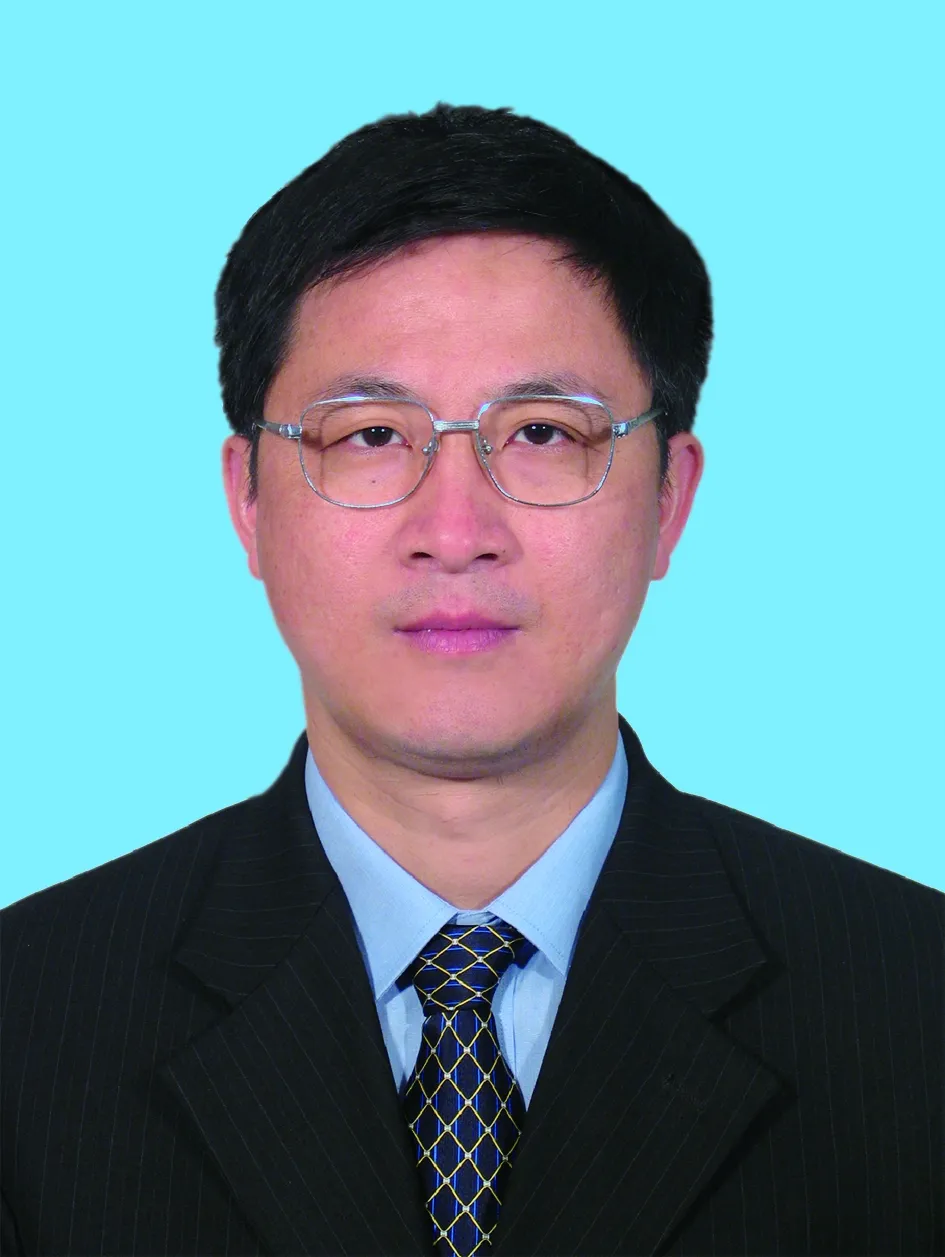
专栏组稿专家简介:
陈坚强(1966-),男,浙江绍兴人,研究员,博导,享受政府特殊津贴。长期从事高超声速空气动力学和CFD研究。现为国家重点研发计划项目“高超声速边界层转捩机理、预测及控制方法研究”首席科学家。获部委级科技进步一、二等奖7项,发表学术论文90余篇。近期研究方向:高超声速边界层转捩、多物理场耦合模拟、高超声速气动力天地相关性等。E-mail: jq-chen@263.net

袁先旭(1974-),男,湖北大冶人,研究员。长期从事非定常空气动力学和飞行器动态特性研究。获部委级科技进步一、二等奖4项,发表学术论文40余篇。近期研究方向:高超声速边界层转捩、多尺度流动模拟。E-mail: yuanxianxu@cardc.cn

